LMRCSC Student Participation in the NOAA Experiential Research and Training Opportunity (NERTO)
Collaboration with NOAA scientists and coordination with the NOAA Science Centers are critical to maintain the relevance of LMRCSC research to NOAA needs, to strengthen partnerships with NOAA, and to introduce fellows to the structure and function of NOAA. In order to facilitate such collaboration, graduate fellows supported by the LMRCSC are required to have a NOAA scientist serve on their advisory committees. Additionally, LMRCSC graduate fellows are required to participate in the NOAA Experiential Research and Training Opportunity (NERTO) program, a 12-week internship at a NOAA lab/facility under the supervision of a NOAA mentor scientist.
LMRCSC Graduate Fellows planning their NERTO internship can login to the ISpring learning management system and self enroll in the course titled, NOAA Experiential Research and Training Opportunities (NERTO). If you need assistance with accessing ISpring, please contact Dr. Young at vyoung1@umes.edu, or call her at 912-358-4291.
LMRCSC NERTO Participants (2023)

Savannah Clax, EPP Intern | Email: claxs@oregonstate.edu
CSC Affiliation: NOAA-Living Marine Resources Cooperative Science Center
Home Institution and Major: Oregon State University – Marine Resources Management
CSC Academic Advisor: Dr. Kelly Biedenweg & Dr. Jessica Miller | Email: jessica.miller@oregonstate.edu
NOAA Internship Mentor: Dr. Jenny Waddell, NWFSC, Olympic Coast National Marine Sanctuary, Seattle, Washington
Email: jenny.waddell@noaa.gov
Project Category: Healthy Habitats
NERTO Title: Supporting Field Research and Public Engagement at Olympic Coast National Marine Sanctuary, Washington
Abstract
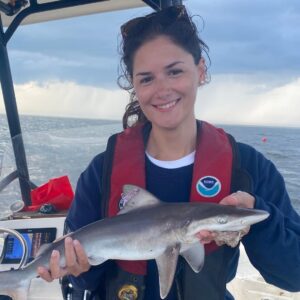
Michelle Fernandez, EPP Intern | Email: michelle.fernandez@earth.miami.edu
CSC Affiliation: NOAA-Living Marine Resources Cooperative Science Center
Home Institution and Major: University of Miami -RSMAS, Marine Biology and Ecology
CSC Academic Advisor: Dr. David Die | Email: ddie@rsmas.miami.edu
NOAA Internship Mentor: Dr. Camilla McCandless, Northeast Fisheries Science Center
Email: cami.mccandless@noaa.gov
Project Category: Healthy Habitats
NERTO Title: Analysis of batoid bycatch from the Delaware Bay COASTSPAN (Cooperative Atlantic States Shark Pupping and Nursery) Surveys
Abstract

Kayland Huckaby, EPP Intern | Email: kfhuckaby@umes.edu
CSC Affiliation: NOAA-Living Marine Resources Cooperative Science Center
Home Institution and Major: University of Maryland Eastern Shore – Marine Estuarine and Environmental Science
CSC Academic Advisor: Dr. Paulinus Chigbu | Email: pchigbu@umes.edu
NOAA Internship Mentor: Drs. Glenn Zapfe & Frank Hernandez, SEFSC, Pascagoula, MS
Email: glenn.zapfe@noaa.gov, frank.hernandez@noaa.gov
Project Category: Healthy Habitats
NERTO Title: Diet and trophic level analysis of groundfish species in the northern Gulf of Mexico
Abstract

Jamon Jordan EPP Intern | Email: jamon.jordan@oregonstate.edu
CSC Affiliation: NOAA-Living Marine Resources Cooperative Science Center
Home Institution and Major: Oregon State University, Marine Resource Management
CSC Academic Advisor: Dr. Maria Kavanaugh | Email: maria.kavanaugh@oregonstate.edu
NOAA Internship Mentor: Dr. Elliott Hazen, Southwest Fisheries Science Center | Email: elliott.hazen@noaa.gov
Project Category: Healthy Habitats
NERTO Title: Opportunity for EPP CSC Graduate Student : Assessing seasonal and subseasonal variability in forage habitat (occupancy) in central California
Abstract
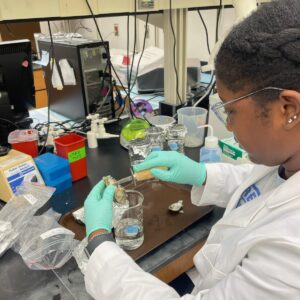
Amria Leyani, EPP Intern | Email: amira.layeni@my.hamptonu.edu
CSC Affiliation: NOAA-Living Marine Resources Cooperative Science Center
Home Institution and Major: Hampton University, Biology–Environmental Track
CSC Academic Advisor: Dr. Joseph Reustel & Dr. Deidre Gibson | Email: joseph.reustle@hamptonu.edu & Deidre.Gibson@hamptonu.edu
NOAA Internship Mentor: Dr. Marie DeLorenzo, Hollings Marine Laboratory
Project Category: Stock Assessment
NERTO Title: Assessment of microplastic pollution in oyster reefs
Abstract
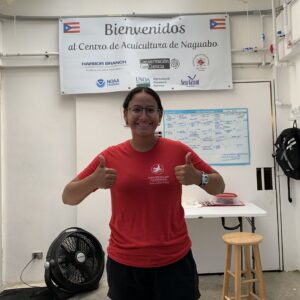
Lucia Ramirez-Joseph, EPP Intern | Email: lucia.joseph@my.hamptonu.edu
CSC Affiliation: NOAA-Living Marine Resources Cooperative Science Center
Home Institution and Major: Hampton University, Biology–Environmental Track
CSC Academic Advisor: Dr. Joseph Reustel & Dr. Deidre Gibson | Email: joseph.reustle@hamptonu.edu & Deidre.Gibson@hamptonu.edu
NOAA Internship Mentor: Dr. Kevin Madley, Northeast Fisheries Science Center | Email: kevin.madley@noaa.gov
Project Category: Stock Assessment
NERTO Title: Assessment of the National Shellfish Initiative (NSI)
Abstract
LMRCSC NERTO Participants (2016 – 2022)
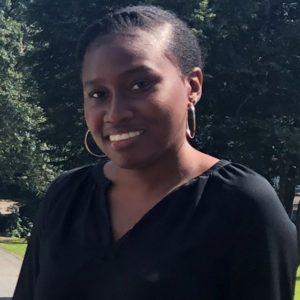
Arona Bender, EPP Intern | Email: arona.bender@my.hamptonu.edu
CSC Affiliation: NOAA-Living Marine Resources Cooperative Science Center
Home Institution and Major: Hampton University, Biology and Environmental Science
CSC Academic Advisor: Dr. Carolina Lewallen, Marine and Environmental Science | Email: carolina.lewallen@hampton.edu
NOAA Internship Mentor: Dr. Douglas Krause NOAA/Southwest Fisheries Science Center/Antarctic Research Division
Email: douglas.krause@noaa.gov
Project Category: Science and Technology Enterprise
NERTO Title: Initial analysis of the foraging tactics and social behavior of Antarctic fur seals (Arctocephalus gazella) from
animal-borne HD video footage
Abstract
Understanding the role of marine predators in Antarctic ecosystems is fundamental to the ecosystem-based management of Antarctic fisheries. In the past, direct observations of Antarctic predator foraging have been difficult, partially due to the lack of adequate technology. However, the development of small, lightweight biologgers such as animal-borne video cameras now make it possible to study the foraging, social, and resting behaviors of marine predators. This study analyzed animal-borne HD video footage to investigate and examine the foraging tactics and social behavior of 2 female Antarctic fur seals in the Southern Ocean during the austral summer of 2018 – 19. Analysis of movie footage from both seals revealed a mean foraging diving depth range between 20 – 49 m. Further, krill capture rates were shown to be related to dive depth, and mean consumption rates of 23 krill per minute, and 12 krill per minute for seals 451 and 57, respectively. This study details the quantitative analysis of consumption rates in free-ranging Antarctic fur seals based on data collected by animal-borne HD video footage.

Brittany King, EPP Intern | Email: brittany.king@oregonstate.edu
CSC Affiliation: NOAA-Living Marine Resources Cooperative Science Center
Home Institution and Major: Oregon State University – Fisheries Science
CSC Academic Advisor: Dr. Kelly Biedenweg & Dr. Jessica Miller, Fisheries and Wildlife | Email: kelly.biedenweg@oregonstate.edu; jessica.miller@oregonstate.edu
NOAA Internship Mentor: Dr. Robby Fonner, NMFS, Northwest Fisheries Science Center, Seattle, Washington
Email: robby.fonner@noaa.gov
Project Category: Resilient Coastal Communities and Economies
NERTO Title: Ecological, Institutional and Social Influences on Habitat Restoration Efforts in Pacific Northwest
Abstract
In the past 20 years, thousands of salmon habitat restoration projects have occurred in the Pacific Northwest, with a focus on the ecological goal of protecting and recovering threatened and endangered salmon species. However, studies in other regions of the United States have found that in addition to the ecological drivers of restoration projects, there are also social factors that potentially influence restoration. To better understand these dynamics, our project investigated the ecological and social influences on the distribution of salmon habitat restoration efforts in the Puget Sound region of Washington state. We aimed to answer the following research question: How does the regional distribution of completed salmon restoration projects correlate with biological, physical, and human community characteristics? Using salmon habitat restoration projects data obtained from the NOAA managed Pacific Northwest Salmon Habitat Project Database as dependent variables, this project explored whether salmon habitat restoration efforts in the Puget Sound tend to flow towards certain types of ecological and social communities, and the potential equity and environmental justice implications. Preliminary statistical count model results suggest that, depending on the project type, restoration effort was highest in lower elevations catchments with higher ESU counts, water quality impairment and high percentages of non-Hispanics white populations.
The Research for this NERTO internship was completed with the Human Dimension team at the NWFSC, which focuses on addressing social, economic, and cultural issues associated with resource management. The main objective of the internship’s research project was to investigate whether the regional distribution of completed salmon habitat restoration project sites in the Puget Sound correlate with biological, physical, and human community characteristics? Understanding whether salmon restoration efforts tends to flow towards certain types of communities, could inform future effort allocations in the Pacific Northwest and raise awareness about potential equity and environmental justice issues. Previous literature on environmental
justice highlights that environmental hazards may disproportionately affect communities with greater susceptibility to unequal environmental protection, however, social and environmental impact assessments are commonly conducted separately (Sanchez et al 2013). Our project was inspired by a similar research that explored correlations between ecological and social variables and restoration sites along the California coast (Stanford et al. 2018), which found that restoration effort was “highest in catchments with water quality impairment, high population density, high pro-environmental voting, and highly educated, wealthy, non-Hispanic white populations (Stanford et al. 2018). Using similar methods, we were interested in exploring whether or not similar ecological and social trends exist within the Pacific Northwest. To complete our research, we utilized NOAA NWFSC’s managed Pacific Northwest Salmon Habitat Project (PNSHP) database which contains data on over 26,000 restoration actions undertaken at over 42,000 locations At the Puget Sound level, PNSHP contains data on over
1500 restoration actions undertaken at over 2100 locations from 2000- 2015. The number of restoration project sites in each catchment unit (12-digit Hydrological Unit Code) within the Puget Sound region were used as dependent variables. Ecological and social variables were collected for each catchment unit to use as independent variables. We the fit statistical count
models to assess the correlations between dependent and independent variables.
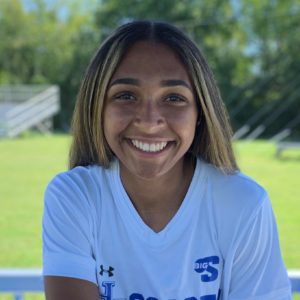
Jaelyn Leslie, EPP Intern | Email: jaelyn.leslie@myhamptonu.edu
CSC Affiliation: NOAA-Living Marine Resources Cooperative Science Center
Home Institution and Major: Hampton University, Biology
CSC Academic Advisor: Dr. Carolina Lewallen, Marine and Environmental Science | Email: carolina.lewallen@hampton.edu
NOAA Internship Mentor: Dr. Douglas Krause NOAA/Southwest Fisheries Science Center/Antarctic Research Division
Email: douglas.krause@noaa.gov
Project Category: Science and Technology Enterprise
NERTO Title: Assessing the mass and body condition of leopard and fur seals using aerial images
Abstract
Changes in the mass and body condition of pinnipeds can provide key information about the health and energetic demands of pinniped populations. We applied a previously developed model to measure the body size and mass of leopard seals at Cape Shirreff, Livingston Island, Antarctic Peninsula. We used an unoccupied aerial system (UAS) to capture single overhead
photographs of leopard seals to assess the changes of body condition and body mass over the course of 4 austral summers (2016-2019). Aerial photogrammetric techniques have proven to be increase accuracy of measurements, be less invasive, and more logistically efficient that historical manual measurement techniques. Leopard seal residency on Cape Shirreff during the
austral summer overlaps with fur seal pupping season. There is strong evidence that leopard seals play a role in the top-down control of fur seal populations, and we hope to gain a better understanding of the health and summer energetic needs.

Josette McLean, EPP Intern | Email: josette.mclean@myhamptonu.edu
CSC Affiliation: NOAA-Living Marine Resources Cooperative Science Center
Home Institution and Major: Hampton University – Biology concentration in Environmental Science
CSC Academic Advisor: Dr. Eric Lewallen, Biological Sciences |
Email: eric.lewallen@hamptonu.edu
NOAA Internship Mentor: Dr. Laurie Weitkamp, NOAA National Marine Fisheries Service/Northwest Fisheries Science Center/ Newport Research Station
Email: laurie.weitkamp@noaa.gov
Project Category: Healthy oceans
NERTO Title: Informing the marine ecology of Pacific lamprey
Abstract
The Pacific lamprey species are a group of anadromous, eel-like, vertebrates that are endemic to the North Pacific. They are an ecologically, culturally and economically important species in the Pacific Northwest region of the United States. Despite their intrinsic value, their populations have declined by approximately 90% in some regions. Currently there is a paucity of information pertaining to their ocean residence phase. Consequently, the goal of this study was to gain insight into the prey species of Pacific lamprey and to determine if lamprey prey are connected to their recent population declines. Lamprey were collected from the Pacific hake (Merluccius productus) fishery and the Pacific pink shrimp fishery (Pandalus jordani) vessels.
The 313 bp COI region of prey mtDNA were extracted according to the Qiagen DNeasy Blood & Tissue Kit protocol; and amplified using Polymer Chain Reactions (PCR). After external sequencing, samples were identified as Pacific lamprey. This highlighted the need for Pacific lamprey DNA blockers in order to identify prey DNA. Currently, I am in the process of creating a protocol to block lamprey DNA based on previous studies and will implement these techniques into my future research. I also wrote a review paper entitled, “eDNA Methodologies for Assessing Genetic Diversity among Marine Populations,” which will be submitted to the Current Molecular Biology Reports Journal.

Keala Pelekai, EPP Intern | Email: keala.pelekai@oregonstate.edu
CSC Affiliation: NOAA-Living Marine Resources Cooperative Science Center
Home Institution and Major: Oregon State University, Fisheries Science
CSC Academic Advisor: Dr. Jessica Miller, Department of Fisheries, Wildlife and Conservation Sciences | Email: jessica.miller@oregonstate.edu
NOAA Internship Mentor: Dr. David Huff, Northwest Fisheries Science Center (NWFSC); Dr. Joe Smith, National Marine Fisheries Service (NMFS), Estuarine and Ocean Ecology Program, Corvallis, Oregon |
Email: david.huff@noaa.gov; joe.m.smith@noaa.gov
Project Category: Healthy Oceans
NERTO Title:Opportunity for EPP Cooperative Science Center Graduate Student: NOAA Acoustic Data Management and Sharing
Abstract
The goals of this internship were multifaceted and included to become familiar with NOAA acoustic data management, with emphasis on “best-practices” for data manipulation and sharing; lead upload of multi-year dataset on acoustic detections of fishes in the Northern California Current into online repositories; format and analyze existing acoustic data for Bull
Trout; and participate in field opportunities to assist with acoustic array deployment in Columbia River estuary or coastal ocean, if safe and allowable. As a result of complications with the remote NERTO format, some of the duties and responsibilities outlined did not come to fruition. The final upload of the Science Center’s acoustic data to the Ocean Tracking Network (OTN) and Animal Telemetry Network (ATN) repositories did not occur due to complications with data access. Furthermore, all field-work opportunities were cancelled due to the pandemic and NOAA’s COVID-19 procedures. However, the LMRCSC intern learned about NOAA acoustic data management protocols and completed spatial analyses of the Bull Trout acoustic detection data. Visualization of the Bull Trout detections in the Hoh and Kalaloch Rivers showed all tagged fish migrated from the Kalaloch River and into the Pacific Ocean and to the Hoh River for reproduction. All individuals then returned to the Kalaloch River to overwinter. Further data are needed on this population to understand why these fish perform this migration.

Kristafer Howard, EPP Intern | Email: kristaferhoward@gmail.com
CSC Affiliation: NOAA-Living Marine Resources Cooperative Science Center
Home Institution and Major: Savannah State University – Master of Marine Science
CSC Academic Advisor: Dr. Dionne Hoskins-Brown, Marine Science |
Email: dionne.hoskins-brown@noaa.gov
NOAA Internship Mentor: Roldan Muñoz- Southeast Fisheries Science Center-Beaufort Laboratory; Nathan Bacheler- Southeast Fisheries Science Center-Beaufort Laboratory |
Email: roldan.munoz@noaa.gov | nate.bacheler@noaa.gov
Project Category: Healthy oceans
NERTO Title: Abiotic and Biotic Factors Influencing the Community Composition of US Southeast Atlantic Fishes from 2015-2019
Abstract
It is the role of a fisheries manager to make informed management decisions using the best data available. To provide managers with this data the Southeast Fisheries Science Center (SEFSC) conducts the Southeast Fishery Independent Survey (SEFIS). This survey was created to collect data on reef fish from hard bottom habitats in the southeast US using a variety of different sampling methods. The present study focused on a five-year subset of presence/absence data collected via video recorded on baited chevron traps. The purpose of this study was to determine which biotic and abiotic factors determine the community composition of fishes in the southeast US Atlantic Ocean from 2015-2019. We utilized permutational multivariate analysis of variance (PERMANOVA). The major finding of the study was that depth, latitude, and relief appear to be the most influential at determining the community composition of fishes. We also examined the dataset and classified a species as tropical if the center of its geographic distribution fell equal to or less than 10 degrees (north or south) latitude. Those species whose center of geographic distribution was greater than 10 degrees latitude were classified as non-tropical. Over the time period of the study, we determined that the percent change in mean abundance of tropical species was significantly greater than non-tropical species overall (across North Carolina, South Carolina, Georgia, and Florida) in the southeast US Atlantic Ocean. The results of this study may prove useful for fisheries managers to help predict the possible expansion of tropical fishes and potential changes in fisheries management.
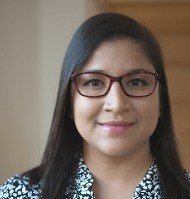
Leanne Cohn, EPP Intern | Email:cohnl@oregonstate.edu
CSC Affiliation: NOAA-Living Marine Resources Cooperative Science Center
Home Institution and Major: Oregon State University- Marine Resource Management
CSC Academic Advisor: Dr. Flaxen Conway, Department of Earth Ocean and Atmospheric Sciences | Email: flaxen.conway@oregonstate.edu
NOAA Internship Mentor: Dr. Blake Feist- Northwest Fisheries Science Center, WA |
Email: blake.feist@noaa.gov
Project Category: Healthy oceans
NERTO Title: Mapping the Footprint of Rockfish Conservation Area (RCA) Closures on the US West Coast, 2021
Abstract
Rockfish (Sebastes spp.) are commercially and ecologically important across the US West Coast. Since the late 1990s and early 2000s, certain rockfish species have been overfished and exploited to the point of severe population decline. Marine protected areas (MPAs) have been established across the US West Coast since 2002 in order to reduce fishing pressure on overexploited rockfish species, and to give their populations the opportunity to recover to sustainable levels. MPAs are not only utilized to rebuild and maintain rockfish populations; they are also used to rebuild and maintain a large breadth of marine natural resources. Rockfish conservation areas (RCAs) are a type of MPA specific to commercially important rockfish species across the US West Coast. RCAs are seasonal and depth specific closures to specific fishing methods such as bottom trawling. The main goal of RCA implementation is to reduce fishing pressure on species that were declared to be ‘overfished’ since
the late 1990s and early 2000s. It is crucial that researchers and managers understand how RCAs impact rockfish populations; one way to achieve this is to quantify and compare fishing activities and rockfish species distributions within RCAs and outside RCAs. Geographic Information Science (GIS) is invaluable to this process as geospatial data layers can be generated and used to overlay and analyze fishing activities with rockfish species distributions across the US West Coast. Such spatiotemporally
dynamic geospatial data layers do not exist yet, therefore, the purpose of this NERTO internship was to assist NOAA with converting 20 years of RCA time series data into usable geospatial data layers that could be used to understand how RCAs impact rockfish populations.

Nicholas Coleman, EPP Intern | Email: ncoleman@umces.edu
CSC Affiliation: NOAA-Living Marine Resources Cooperative Science Center
Home Institution and Major: University of Maryland Center for Environmental
Science (UMCES) Chesapeake Biological Laboratory (CBL)
CSC Academic Advisor: Dr. David Secor, Fisheries Science |
Email: secor@umces.edu
NOAA Internship Mentor: Dr. Steven Lindley and Dr. Peter Dudley, Fisheries Ecology Division, NOAA Southwest Fisheries Science Center, Santa Cruz, California |
Email: steve.lindley@noaa.gov and peter.dudley@noaa.gov
Project Category: Healthy oceans
NERTO Title: Sonar Censusing and habitat use by spawning run Green Sturgeon, Acipenser medirostris
Abstract
The southern distinct population segment (sDPS) of green sturgeon (Acipenser medirostris) that spawn in the Sacramento River is currently listed as “Threatened” under the Endanger Species Act (ESA). The greatest threats to this population are habitat impediments (dams), habitat degradation, and habitat loss which have occurred consistently since the 1950s due to water diversion efforts. Since the sDPS of green sturgeon was listed as “Threatened” in 2006, a substantial amount of research and conservation has been conducted to understand this population’s habitat use and monitor population abundance. The objective of this study was to identify annual fluctuations in spawning run size and how such fluctuations correlate with
environmental variables (i.e. temperature and flow). Additionally, this study attempted to delineate patterns in habitat use for spawning run individuals. Dual-frequency Identification Sonar (DIDSON), a type of acoustic camera, was used to detect the presence of green sturgeon in the Sacramento River during mobile surveys conducted in May/June from 2010 to 2020. The
video collected from these surveys was used to count individual sturgeon at sampled units which were then used to calculate annual estimates of abundance for spawning run sturgeon in the Sacramento River. Annual estimates of abundance were used to investigate correlations with temperature and flow, identify annual fluctuations in spawning run size, and assess patterns in
habitat use. The results from this study found that April flow was the environmental variable with the strongest correlation to annual spawning run size. Four “hot spots” that consistently supported above average abundances of green sturgeon were also identified.

Victoria Moreno, EPP Intern | Email: willvict@oregonstate.edu
CSC Affiliation: NOAA-Living Marine Resources Cooperative Science Center
Home Institution and Major: Oregon State University, Master of Public Policy
CSC Academic Advisor: Dr. Ana Spalding, Oregon State University College of Liberal Arts, School of Public Policy, Assistant Professor of Marine and Coastal Policy | Email: ana.spalding@oregonstate.edu
NOAA Internship Mentor: Dr. Shallin Busch Conservation Biology Division Deputy Director, Northwest Fisheries Science Center, Seattle WA | Email: shallin.busch@noaa.gov
Project Category: Resilient Coastal Communities and Economies
NERTO Title: Collaboratively Combating Ocean Acidification: Assessing the economic vulnerability of US communities to Ocean Acidification
Abstract
The rise of atmospheric CO2 concentrations due to anthropogenic activities has had a broad range of effects on earth systems, including ocean acidification (OA). OA is a threat to marine species and ecosystems and the human systems that rely on them. Throughout the United States, industries and communities that depend on the cultivation of shellfish and wild-capture species as major resources are expected to experience impacts of OA as production levels are disrupted by changing ocean chemistry. For action to be taken at the Federal, state, and local levels through policy and management regarding OA mitigation and adaption, a uniform framework must be established to help communities and industries and the governmental systems associated with them respond effectively to future change. This research project aimed to create and assess a framework for the Federal, state, local agencies to implement effective policies and initiatives related to OA in the US. Through an in-depth interdisciplinary literature review on vulnerability, a framework was developed to assess vulnerability at a national scale in an interdisciplinary fashion. Throughout the project, there was also the engagement of communicating scientific efforts surrounding OA vulnerability and initiatives to the public, explicitly interacting with Federal and public lines of communication and information transfer.

Adrianne Wilson, EPP Intern | Email: adrianne.wilson@rsmas.miami.edu
CSC Affiliation: NOAA-Living Marine Resources Cooperative Science Center
Home Institution and Major: University of Miami-RSMAS, Ph.D., Marine Biology and Ecology
CSC Academic Advisor: Dr. Elizabeth Babcock, Marine Biology and Ecology | Email: ebabcock@rsmas.miami.edu
NOAA Internship Mentor: Dr. Robert Allman, NMFS, SEFSC, Panama City, FL | Email: robert.allman@noaa.gov
Project Category: Healthy oceans
NERTO Title: Age and Growth of Lane Snapper in the Gulf of Mexico
Abstract
The sagittal otoliths for 499 Lane Snapper (Lutjanus synagris) were collected, processed and aged. Samples were collected from the Gulf of Mexico, ranging from the southwest tip of Florida to the eastern portion of Texas from January 2015 to October 2017. Otoliths were sectioned, mounted to a microscope slide and aged using a compound microscope. One reader counted annuli and sub-samples were read by a second reader to ensure consistent and accurate ageing. Fork length measurements ranged from 202mm to 495mm. The oldest fish aged was 13 years. There was a significant difference in the growth parameter estimates between males and females so they were analyzed separately. The von Bertalanffy growth parameters were for males: growth coefficient, K = 0.462, asymptotic length, L00 =378.17, and t0 = -0.868; and for females: growth coefficient, K =0.271, asymptotic length, L00 =383.42, and t0 = -2.08).
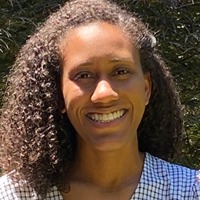
Amanda Lawrence, EPP Intern | Email: alawrence@umces.edu
CSC Affiliation: NOAA-Living Marine Resources Cooperative Science Center
Home Institution and Major: IMET – UMCES; M.S., Marine, Estuarine and Environmental Science Program
CSC Academic Advisor: Dr. J. Sook Chung, Marine & Environmental Technology | Email: chung@umces.edu
NOAA Internship Mentor: Dr. Paul McElhany, NWFSC, Mukilteo Field Station, Ocean Acidification | Email: paul.mcelhany@noaa.gov
Project Category: Healthy Oceans
NERTO Title: Developing methods to detect the effect of CO2 on the physiology of Dungeness crab
Abstract
Atmospheric CO2 concentrations have increased from approximately 280 parts per million (ppm) to 387 ppm since the start of the industrial revolution (Feely and Doney et al., 2009). Current CO2 concentrations exceed that of levels that have not been observed in over 800,000 years (Luthi et al., 2008). This increased abundance in atmospheric CO2 has resulted in the oceans absorbing approximately one-quarter of anthropogenic CO2 (Sabine and Feely, 2007). This shift in oceanic conditions drives chemical changes that have the potential to leave ecosystems and a range of species at risk. Effects of projected seawater CO2 levels have been shown to alter olfactory-mediated behaviors in the economically and environmentally important Coho salmon (Williams et al., 2019). Gill breathers regulate internal pH through the process of ion transport, which is a process directly influenced by the changing water chemistry. More specifically, nearshore benthic ecosystems and calcareous species are predicted to experience some of the more severe impacts regarding a lowering pH (Wootton et al., 2008). Here we will utilize respiration rate to determine the energetic cost of maintaining internal pH in future oceanic conditions, specifically throughout the development of the Dungeness crab, Cancer magister.

Amanda Pappas, EPP Intern | Email: akpappas09@students.desu.edu
CSC Affiliation: NOAA-Living Marine Resources Cooperative Science Center
Home Institution and Major: Delaware State University, M.S. Natural Resources
CSC Academic Advisor: Dr. Gulnihal Ozbay, Marine Biology and Ecology | Email: gozbay@desu.edu
NOAA Internship Mentor: Dr. Gary Wikfors, Northeast Fisheries Science Center Milford, CT | Email: gary.wikfors@noaa.gov
Project Category: Resilient Coastal Communities and Economies
NERTO Title: Change in Photosynthetic Efficiency and Chlorophyll Fluorescence over Time in Prey Starved Dinophysis acuminata
Abstract
Dinophysis acuminata is an obligate mixotrophic dinoflagellate that is found in coastal marine water of the Atlantic and Pacific Ocean, brackish water tributaries, and bays. Dinophysis acuminata is known in many cases to produce toxins of okadaic acid, Dinophysis toxins, and pectenotoxins. These toxins are associated with Diarrhetic Shellfish poisoning in humans. Dinophysis acuminata is emerging as a potential threat to the developing oyster aquaculture industry in the Delaware Inland Bays. There are sites within the Delaware Inland Bays that D. acuminata has been present in high concentrations, but how close spring blooms of D. acuminata come to shellfish aquaculture sites is not known. Little is known of the bloom dynamics of this harmful algae bloom species within the Delaware Inland Bays. The results of this study will aid in determining how long chloroplasts acquired by D. acuminata through kleptoplasty remain functional under prey starved conditions. Nutrients, light, and prey availability are drivers of spring blooms. Understanding how long chloroplasts remain capable of photosynthesis in D. acuminata can inform questions on bloom dynamics and overwintering strategies. Culture of Dinophysis acuminata was fed prey, Mesodinium rubrum and then starved. Results from a Fluorescence Induction and Relaxation System show a decline in the variable fluorescence (Fv/Fm) over time, indicating that the maximum quantum yield of photochemical quenching in PSII is decreasing with time. Results at 25 days indicate a decrease from Fv/Fm of 0.56 to 0.48. Results of a linear regression analysis of the data show little variability between mean data points and relation between Fv/Fm and time. Sampling and data analysis are still being performed.

Detbra Rosales, EPP Intern | Email: drosales@umes.edu
CSC Affiliation: NOAA-Living Marine Resources Cooperative Science Center
Home Institution and Major: University of Maryland Eastern Shore, Ph.D., Marine, Estuarine Environmental Science
CSC Academic Advisor: Dr. Joseph Pitula, Department of Natural Sciences | Email: jspitula@umes.edu
NOAA Internship Mentor: Dr. John Jacobs, NOAA/NCCOS/Oxford Lab. | Email: john.jacobs@noaa.gov
Project Category: Seafood Safety
NERTO Title: The Influence of okadaic acid on gene expression and bacterial susceptibility
Abstract
Diuretic shellfish poisoning (DSP) is a worldwide problem for bivalve aquaculture. Due to the presence of DSP toxins in oysters at concentrations that exceed set regulatory limits, there have been many closures to shellfish harvesting. This can lead to significant economic loses in both commercial and recreational shellfish industries. The eastern oyster, Crassostrea virginica, can accumulate diuretic shellfish toxins (DST) when exposed to marine dinoflagellates that produce DSTs. Dinophysis and Prorocentrum are two dinoflagellate genera commonly found in Mid-Atlantic waters that are known to produce DSTs. Studies have shown that dinoflagellate toxins producers, such as Alexandrium catenella can increase oysters’ susceptibility to bacterial infections. However studies on how okadaic acid affects oysters susceptibility is scarce. Our goal is to provide insight on the stress response of C. virginica after laboratory exposure to OA and the bacterial pathogen Vibrio parahaemolyticus, through the analysis of the expression of HSP70 (Heat shock protein 70) and CP450 (Cytochrome p450) stress genes.

Emily Griffin, EPP Intern
CSC Affiliation: NOAA-Living Marine Resources Cooperative Science Center
Home Institution and Major: Savannah State University, M.S., Marine Science
CSC Academic Advisor: Dr. Tara Cox, Department of Marine Science | Email: coxt@savannahstate.edu
NOAA Internship Mentor: Dr. Patricia Rosel, NOAA Lafayette, Louisiana. | Email: patricia.rosel@noaa.gov
Project Category: Healthy Oceans
NERTO Title: Evaluation of the Southern Border of the Northern Georgia/Southern South Carolina Estuarine System stock of Common Bottlenose Dolphins (Tursiops truncatus) through Genetic Analyses
Abstract
The goal of this research is to learn the proper techniques to identify the correct stock boundaries of bottlenose dolphins. Identifying proper stock boundaries is essential for the proper management of protected species such as the common bottlenose dolphin (Tursiops truncatus). This project is looking at potential genetic differences in bottlenose dolphin stocks off the coast of Northern Georgia. Biopsy samples were collected from dolphins in this region and will be taken to the Lafayette laboratory for further genetic analyses. The NGSSCES stock meets the Central Georgia Estuarine Stock at northern Ossabaw Sound just south of Savannah, Ga. However, recent research suggests this boundary needs to be re-evaluated. The information obtained while working in this lab will inform us if the southern border of the NGGSCES stock is accurate. Through the genetic work we will also have the opportunity to determine the sex of these animals as is very difficult to do in the field.

Enid C. Muñoz Ruiz, EPP Intern | Email: ecmunoz@umes.edu
CSC Affiliation: NOAA-Living Marine Resources Cooperative Science Center
Home Institution and Major: University of Maryland Eastern Shore; M.S., Aquatic Toxicology
CSC Academic Advisor: Dr. Ali Ishaque, Department of Natural Science | Email: abishaque@umes.edu
NOAA Internship Mentor: Dr. Ashok Deshpande, 732-872-3043, NEFSC, Sandy Hook, NJ. | Email: ashok.deshpande@noaa.gov
Project Category: Healthy Habitats
NERTO Title: Method development of Polybrominated Diphenyl Ethers (PBDEs) QUECHERS extraction in Scallops
Abstract
Plastic fragments, pellets, fibers and cosmetic beads less than 5 mm in size are termed as microplastics. These are emerging contaminants that in recent years have been found in tap water samples all over the world and a in a vast array of aquatic organisms with the possibility of toxic effects in them. Multiple studies have implied that, polybrominated diphenyl ethers (PBDEs), persistent bioaccumulative fire-retardant pollutants, in fish tissues display positive correlations with geographic plastic debris densities. Examination of this linear relationship with respect to the benthic environment using sea scallops as model organism is the research main focus. Scallop and bottom water column samples were collected from multiple regions across Georges Bank and Mid-Atlantic Bight. The optimum extraction method to yield the optimum quantification of hydrophobic bioaccumulative compounds in the Atlantic Sea Scallop, Placopecten magellanicus, using modern solid phase extraction “quick, easy, cheap, effective, rugged, and safe” (QUECHERS) has been obtained. Sea scallops are important commercial organisms with fisheries dredging over 50 million pounds annually for seafood consumption; our research directly contributes to NOAA’s goal to conserve and manage coastal and marine ecosystems and resources by providing the scientific foundation for understanding many future studies of the dangers microplastics can have on important ecological commercial species.

Halie O’Farrell, EPP Intern | Email: hofarrell@rsmas.miami.edu
CSC Affiliation: NOAA-Living Marine Resources Cooperative Science Center
Home Institution and Major: University of Miami-RSMAS; Ph.D., Marine Biology and Fisheries
CSC Academic Advisor: Dr. Elizabeth Babcock, Marine Biology and Ecology | Email: ebabcock@rsmas.miami.edu
NOAA Internship Mentor: Dr. Enric Cortes, NOAA NMFS Panama City Field Laboratory, Panama City, Florida | Email: enric.cortes@noaa.gov
Project Category: Healthy Oceans
NERTO Title: Comparing shark harvest control rules to potential biological removals when determining total allowable catches
Abstract
The Magnuson-Stevens Fishery Conservation and Management Act requires fisheries management councils to avoid overfishing by setting total allowable catch (TAC) limits. Currently, shark species’ TACs are set by estimating the relative abundance and projecting forward 20 years under various catch levels while accounting for uncertainty. The TAC is the catch level at which there is a 70% probability that the stock is not overfished in the projection period. While the use of projections is an established method used for many fish species, it is very complicated requiring a lot of information for several parameters and high computing time. In a climate where more stock assessments and management decisions are being requested in less time with fewer resources, a simpler, more efficient method for determining TACs is needed. Management of protected marine mammals utilized the potential biological removals (PBR) approach to set limits. Calculation of a PBR requires little information and they can be computed quickly. Because sharks have a similar life history to marine mammals we explore the possibility of using the PBR method as a more efficient method of establishing TACs. For the purposes of this exploratory work, shark species were limited to those assessed and managed in the south east United States and by the International Commission for the Conservation of Atlantic Tunas (ICCAT). TAC values were extracted from the latest stock assessments for each species, in addition to the information required to calculate a PBR. TAC and PBR values are compared to determine the validity of using the PBR method. This method has showed promise, but is not yet adequately supported as a viable solution.
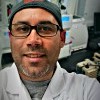
Jorge J. Rodriguez, EPP Intern | Email: jjrodriguez@umes.edu
CSC Affiliation: NOAA-Living Marine Resources Cooperative Science Center
Home Institution and Major: University of Maryland Eastern Shore, PhD., Marine Estuarine Environmental Sciences
CSC Academic Advisor: Dr. A. K. Nyame, Department of Natural Sciences | Email: aknyame@gmail.com
NOAA Internship Mentors: Dr. Gary Wikfors | Email: gary.wikfors@noaa.gov & Dr. April Croxton | Email: april.croxton@noaa.gov; NOAA Lab, Milford, CT
Project Category: Cytology/Molecular Biology
NERTO Title: Use of density step gradient centrifugation and differential lectin binding to characterize Mytilus edulis hemocyte subpopulations by flow cytometry
Abstract
Mytilus edulis, commonly known as the blue mussel, relies on circulating hemocytes to eliminate invading pathogens. However, there is a lack of knowledge about other functions hemocytes may carry, as well as their life-cycle and ontogeny. Currently, hemocyte subpopulations are classified by morphological differences observed through light microscopy. Here we report the elucidation of two hemocyte subpopulations based on density step-gradient centrifugation combined with the differential binding of Fluorescein (FITC)-conjugated Aleuria aurantia lectin (AAL) and FITC-conjugated wheat germ agglutinin (WGA) to cell surface glycoproteins. Earlier lectin blot studies demonstrated that soluble hemocyte extracts from M. edulis hemocytes express glycoconjugates with terminal fucose and N-acetylglucosamine carbohydrate moieties. Flow cytometry analysis of FITC-conjugated AAL and FITC-conjugated WGA stained hemocytes demonstrate the presence of terminal fucose and N-acetylglucosamine carbohydrate moieties on M. edulis cell surface glycoconjugates. Additional studies reveal that the majority of these terminal carbohydrates are found on protein backbones that are susceptible to cleavage with trypsin, a protease known to cleave the carboxyl side of peptides containing lysine or arginine. The expression of these terminal carbohydrate moieties is not evenly distributed among hemocytes. Here we report that approximately 30% of hemocytes express glycoproteins with terminal N-acetylglucosamine, while 70% of hemocytes express glycoproteins with terminal fucose and N-acetylglucosamine. The expression of terminal fucose and N- acetylglucosamine increases as hemocytes increase in size and level of granularity. Interestingly, smaller agranular hemocytes do not express terminal fucose. These results show the presence of two distinct M. edulis hemocyte subpopulations based on the differential expression of cell surface glycoproteins with terminal N-acetylglucosamine only, or terminal fucose and N-acetylglucosamine.
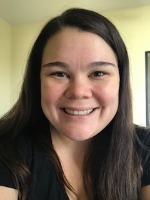
Kasondra Rubalcava, EPP Intern | Email: kdrubalcava@umes.edu
CSC Affiliation: NOAA-Living Marine Resources Cooperative Science Center
Home Institution and Major: University of Maryland Eastern Shore, PhD., Marine, Estuarine Environmental Sciences
CSC Academic Advisor: Dr. Paulinus Chigbu, Department of Natural Sciences | Email: pchigbu@umes.edu
NOAA Internship Mentor: Dr. Howard Townsend, NOAA/NMFS/ST/Ecosystems, Cooperative Oxford Laboratory, Oxford, MD | Email: howard.townsend@noaa.gov
Project Category: Climate Adaptation and Mitigation
NERTO Title: Development of a Maryland Coastal Bays Ecosystem Model to Assess the Influence of Climatic Factors on Biomass Distributions of Fish and Macroinvertebrates, Food Web Linkages and Community Structure
Abstract
The Maryland Coastal Bays (MCBs) are a system of shallow lagoons on the US East Coast connected to the Atlantic Ocean by two inlets. They are one of the most ecologically diverse estuaries on the east coast and serve as a nursery for many commercially important species such as black sea bass, summer flounder and blue crabs. Due to their significant use by the public, MCBs are vulnerable to environmental and human pressures. Understanding how environmental parameters affect the ecosystem can help in managing a changing ecosystem. We created a fisheries ecosystem model consisting of 22 functional groups and species from the MCBs using Ecopath with Ecosim (EwE) software to explore influence of environmental factors on biomass distributions of key fish species including summer flounder, black sea bass, bay anchovy, weakfish, and blue crab. The biomass input data used for Ecopath was estimated from abundance index data through the Maryland Department of Natural Resources (MDDNR) Coastal Bays Fisheries Investigation Trawl and Beach Seine Survey. Time series data imported from 1990-2017 through the MDDNR survey was used to fit the model. Climate change scenarios were run using changes in temperature and salinity to analyze the effects they have on key species in the MCBs. The results of this study will aid in management of the MCBs as it is a nursery habitat for commercially important species.

LaTreese S. Denson, EPP Intern | Email: ldenson@rsmas.miami.edu
CSC Affiliation: NOAA-Living Marine Resources Cooperative Science Center
Home Institution and Major: University of Miami – RSMAS, PhD., Marine Biology and Ecology
CSC Academic Advisor: Dr. Elizabeth Babcock, Marine Biology and Ecology | Email: ebabcock@rsmas.miami.edu
NOAA Internship Mentor: Dr. James Thorson, NMFS, Alaska Fisheries Science Center, HEPR, Seattle, Washington | Email: james.thorson@noaa.gov
Project Category: Healthy Oceans
NERTO Title: Environmental influences on indices of abundance for King Mackerel in the Gulf of Mexico examined through spatiotemporal geostatistical models
Abstract
During the NERTO experience from September to December 2018, I developed skills in random effects modeling to understand spatial processes in fish population dynamics, here-in referred to as geostatistical modeling. These models were tested using larval count data from the Southeast Area Monitoring and Assessment Program (SEAMAP) Fall Plankton Survey. Originally, a non-geostatistical model was fit to the data to derive an index of abundance for spawning stock biomass; however, the original index did not explicitly account for the uncertainty in spatial variation on population density or catchability. Failing to account for this source of uncertainty in a model, underestimates the overall uncertainty of an index of abundance. During the NERTO I began to explore the effect of spatial and spatiotemporal variability using a geostatistical model on King mackerel ichthyoplankton abundance indices and density distribution. I began with the use of delta-log normal models for zero inflated data. As expected, considering spatial variability creates a better model according to the Akaike Information Criterion. Additionally, adding spatial and temporal variability to the original model only slightly increases the standard deviation (uncertainty) of the index of abundance. Future research will include using Poisson-link models to better describe the error structure and variability in the data. I will also further investigate the individual contribution of the original covariates when considering spatial structure as well as environmental covariates such as temperature and chlorophyll.
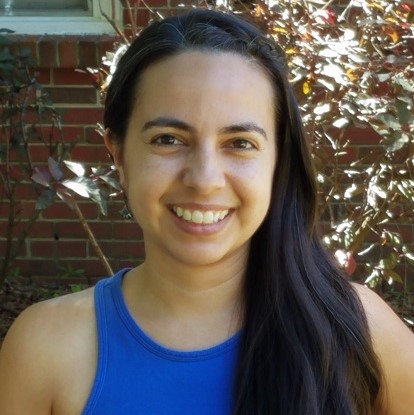
Laura Almodóvar-Acevedo, EPP Intern | Email: lcalmodovaracevedo@umes.edu
CSC Affiliation: NOAA-Living Marine Resources Cooperative Science Center
Home Institution and Major: University of Maryland Eastern Shore, PhD., Marine, Estuarine Environmental Sciences
CSC Academic Advisor: Dr. Bradley Stevens, Department of Natural Sciences | Email: bgstevens@umes.edu
NOAA Internship Mentor: Dr. Howard Townsend, NOAA/NMFS/ST/Ecosystems, Cooperative Oxford Laboratory, Oxford, MD | Email: howard.townsend@noaa.gov
Project Category: Healthy Habitats
Abstract
The objective of this study is to have empirical data about black sea bass respiration rates at different temperatures. This information will give us a better idea of black sea bass bioenergetics and will also be incorporated into a juvenile black sea bass habitat suitability model for the Chesapeake Bay.
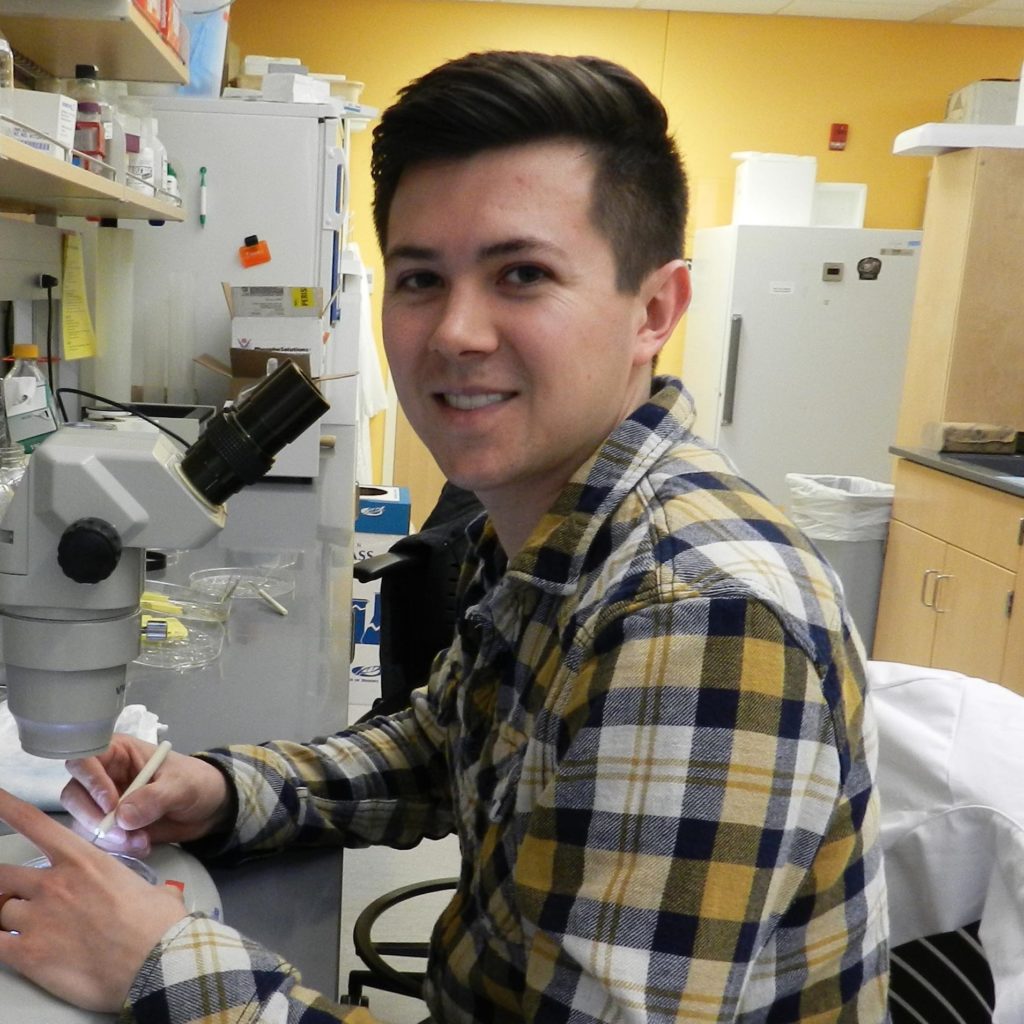
Matthew Ramirez, EPP Intern | Email: matthew.ramirez@oregonstate.edu
CSC Affiliation: NOAA-Living Marine Resources Cooperative Science Center
Home Institution and Major: Oregon State University, PhD., Fisheries Science
CSC Academic Advisor: Dr. Selina Heppell, Department of Fisheries and Wildlife | Email: selina.heppell@oregonstate.edu
NOAA Internship Mentor: Dr. Jeffrey E. Moore, CMAP Leader (California Current Marine Mammal Assessment Program), Marine Mammal and Turtle Division, NOAA Southwest Fisheries Science Center, La Jolla, CA | Email: jeff.e.moore@noaa.gov
Project Category: Healthy Oceans
NERTO Title: Integration of habitat-specific growth variation into assessment models: a case study in the Kemp’s ridley sea turtle
Abstract
Spatiotemporal variation in demographic parameters can strongly influence a species’ population dynamics but is generally not included in sea turtle population models due in part to lack of sufficient data. For example, Kemp’s ridley sea turtles that inhabit the U.S. Atlantic Coast grow slower than conspecifics that inhabit the U.S. Gulf of Mexico (GoM) Coast, which may lead to differences in age at maturation for individuals or whole cohorts. To evaluate the influence of this variation on Kemp’s ridley population dynamics, this NERTO experience focused on developing an improved age-structured population model for Kemp’s ridley sea turtles that incorporates habitat-specific vital rate estimates (growth, survival). Using a ~30 year dataset of somatic growth rates obtained through skeletochronology, we developed habitat-specific (Atlantic, GoM) maturation schedules for this species. In addition, ongoing analyses are using 20 years of stranding length frequency data collected through the Sea Turtle Stranding and Salvage Network to estimate habitat-specific survival rates that will be included in the model. Ongoing analyses will examine model sensitivity to changes in stage-and habitat-specific model parameters. This project will help answer critical question about the contribution of somatic growth variation, habitat use, and Atlantic turtles, which have been excluded from all existing population models, to Kemp’s ridley population dynamics.
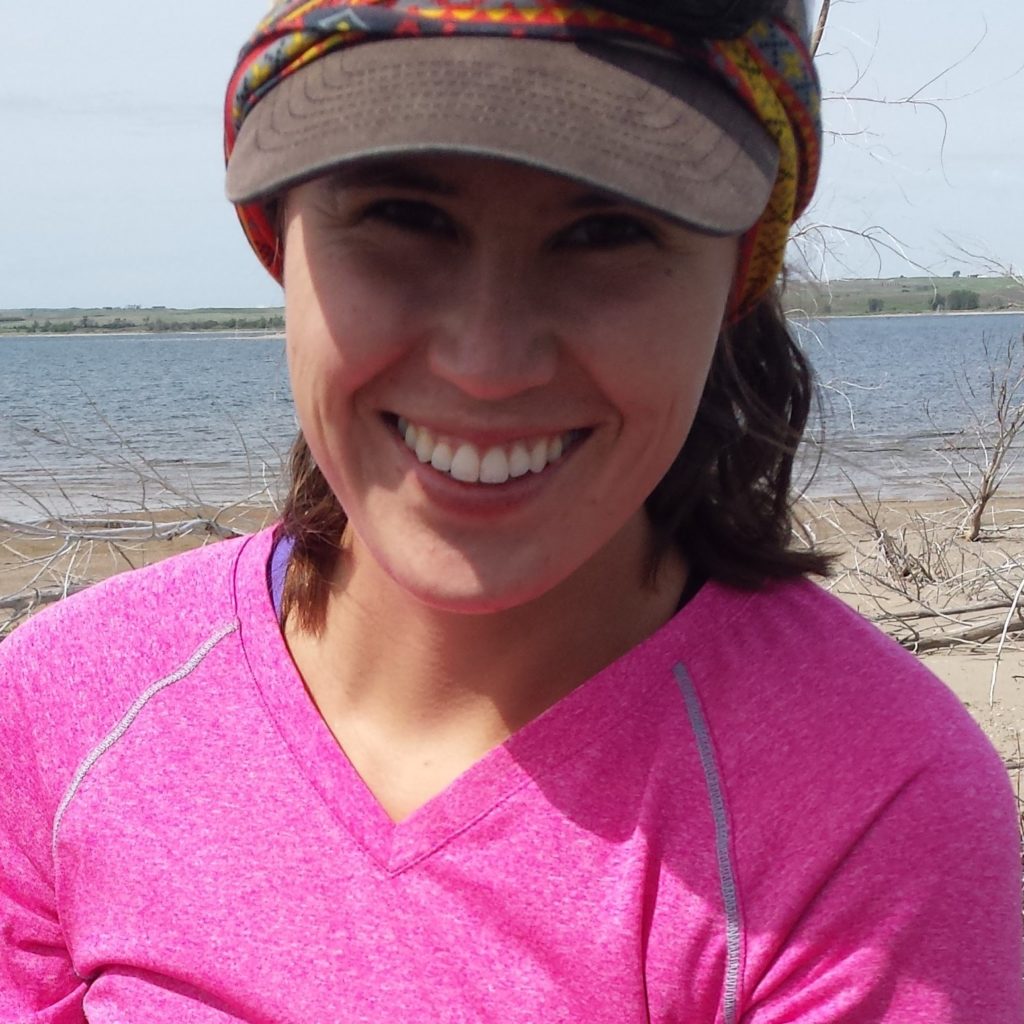
Nicole Kleponis, EPP Intern | Email: nicolekleponis@gmail.com
CSC Affiliation: NOAA-Living Marine Resources Cooperative Science Center
Home Institution and Major: Delaware State University, M.S., Natural Resources
CSC Academic Advisor: Dr. Christopher Heckscher, Agriculture and Natural Resources | Email: checkscher@desu.edu
NOAA Internship Mentor: Dr. Jeannette E. Zamon, NOAA-National Marine Fisheries Service, NWFSC, Point Adams Research Station, Hammond, OR | Email: jen.zamon@noaa.gov
Project Category: Healthy Oceans
NERTO Title: Seabird Capture and Diet Analysis
Abstract
Seabird populations have been declining globally and there is little diet information for seabirds in the Colombia River Plume in Oregon. Sooty Shearwaters and Common Murres were captured to obtain stomach content for analysis. Soft tissue analysis was first conducted and then the samples were digested to conduct hard part analysis. The majority of fish found in the 2013 samples analyzed were anchovies.

Rebecca Wenker, EPP Intern | Email: rwenker@umes.edu
CSC Affiliation: NOAA-Living Marine Resources Cooperative Science Center
Home Institution and Major: University of Maryland Eastern Shore, M.S., Marine, Estuarine Environmental Sciences
CSC Academic Advisor: Dr. Bradley Stevens, Department of Natural Sciences | Email: bgstevens@umes.edu
NOAA Internship Mentor: Dr. Vincent Guida, NMFS NEFSC J.J. Howard Lab, Highlands, NJ. | Email: vincent.guida@noaa.gov
Project Category: Healthy Oceans
NERTO Title: Development of alternative search strategy for assessing densities of clumped distribution species within a comprehensive image database
Abstract
The systematic search strategy currently used for photo evaluation of large image databases does not work well for species with clumped distributions. Therefore, we planned to develop an adaptive search strategy to better define the habitat of and relationship between black sea bass (Centropristis striata) and sea whip coral (Leptogorgia virgulata), which could then be extrapolated to evaluating other species with a clumped distribution. Unprecedented delays and setbacks prevented this study from being completed to the original extent desired. However, we were able to locate 92 images where at least one black sea bass was present, and 57 where at least one sea whip coral was present. The close proximity and overlap of these images further supports the notion that there is a relationship between these two species.
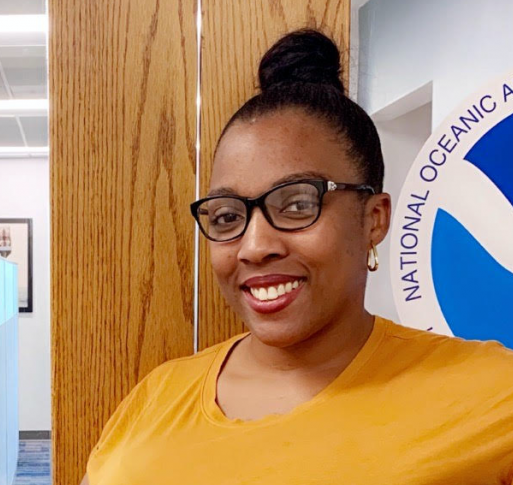
Shadaesha Green, EPP Intern | Email: sgreen@umces.edu
CSC Affiliation: NOAA-Living Marine Resources Cooperative Science Center
Home Institution and Major: IMET – UMCES; PhD., Marine, Estuarine and Environmental Science Program
CSC Academic Advisor: Dr. J. Sook Chung, Marine & Environmental Technology | Email: chung@umces.edu
NOAA Internship Mentor: Mr. Bruce Vogt, NOAA Chesapeake Bay Office, MD | Email: bruce.vogt@noaa.gov
Project Category: Healthy Oceans
NERTO Title: Striped Bass Habitat Indicator for Chesapeake Bay
Abstract
The Chesapeake Bay striped bass (Rockfish) is an iconic species. The Chesapeake Bay serves as the largest nursery habitat for Atlantic striped bass. The main objective of this study was to improve the understanding of nursery habitat areas for juvenile striped bass that support survival and recruitment to the adult population. This project was two-fold: (1) develop a conceptual model indicating factors impacting juvenile striped bass nursery habitat and (2) prepare the Chesapeake Bay striped bass nursery habitat assessment’ Request-for-Proposal (RFP) for submission to the Chesapeake Bay Trust. To complete these tasks interviews were conducted with a variety of scientists and fishery managers in the Chesapeake Bay region to gather their insight on factors influencing nursery habitat for juvenile striped bass.

Shanelle Haughton, EPP Intern | Email: sohaughon@umes.edu
CSC Affiliation: NOAA-Living Marine Resources Cooperative Science Center
Home Institution and Major: University of Maryland Eastern Shore, PhD., Marine, Estuarine Environmental Sciences
CSC Academic Advisor: Dr. Joseph Pitula; Department of Natural Sciences | Email: jspitula@umes.edu
NOAA Internship Mentor: Dr. Pamela Jensen, NOAA Western Regional Center, Seattle, WA | Email: pam.jensen@noaa.gov
Project Category: Climate Adaptation and Mitigation
NERTO Title: Understanding Hematodinium sp. in Alaskan crabs: new hosts, improved detection and health effects in a changing ocean
Abstract
Changes in environmental conditions due to climate change, including increases in sea water temperature, may be linked to increasing rates of pathogen infection in marine animals. One of the pathogens in which host selectivity and prevalence could be influenced by factors like increasing water temperature is Hematodinium sp., an endoparasitic dinoflagellate that can cause significant mortality and economic loss in crustacean fisheries. Hematodinium sp. causes bitter crab disease/syndrome in the economically important snow and Tanner crabs, a fatal infection characterized by lethargy and discoloration of host tissues and carapace due to massive numbers of parasites in host hemolymph and tissues. Work completed during this internship will contribute to future research to better understand the influence of Hematodinium sp. infection on Tanner crab immunity and physiology. My work during this internship consisted of three major parts: 16s sequencing mini project, Tanner crab (Chionoecetes bairdi) sample collection, and Tanner crab RNA extractions.
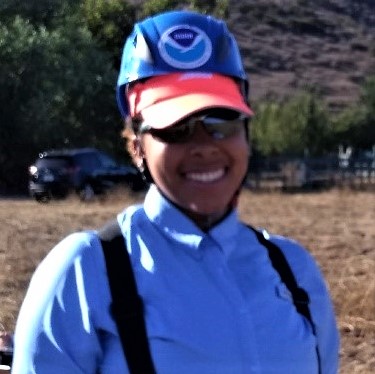
Shaneese Mackey, EPP Intern | Email: shaneesemackey19@gmail.com
CSC Affiliation: NOAA-Living Marine Resources Cooperative Science Center
Home Institution and Major: Savannah State University, M.S., Marine Science
CSC Academic Advisor: Dr. Dionne Hoskins-Brown, Department of Marine Science | Email: hoskins@savannahstate.edu
NOAA Internship Mentor: Dr. Ron Hill, NOAA SEFSC Galveston Lab, TX | Email: ron.hill@noaa.gov
Project Category: Healthy Oceans
NERTO Title: UAS Habitat Assessment Project
Abstract
Advancing technology like unmanned aircrafts (UA) can be used by scientists to collect information about the abundance or density of a species that would normally require human efforts. Usage of UAs increases field efficiency and decreases the amount of effort while being less invasive to the environment. The purpose of this study was to determine the feasibility of using unmanned aerial system (UAS) to assess oyster reefs and wetland habitat. Images of oyster reefs were collected using the APH-28 Hexa-copter during low tide. Images were stored on an external hard drive, uploaded to Drone2Map for stitching, then brought into ArcGIS 10.6 to perform spatial analysis using the Hogland method. Using the Hogland method on obtained UA images would increase the estimation of potential fish habitat at a resolution of 1m. The findings of this project would help project managers be less invasive to the environment while obtaining data on the species and habitat.
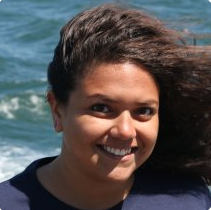
Stephanie Martinez-Rivera, EPP Intern | Email: smartinez@umes.edu
CSC Affiliation: NOAA-Living Marine Resources Cooperative Science Center
Home Institution and Major: University of Maryland Eastern Shore, PhD., Marine, Estuarine Environmental Sciences
CSC Academic Advisor: Dr. Bradley Stevens, Department of Natural Sciences | Email: bgstevens@umes.edu
NOAA Internship Mentor: Dr. Chris Long, NOAA AFSC, Kodiak Lab, Alaska | Email: chris.long@noaa.gov
Project Category: Healthy Oceans
NERTO Title: Eastern Bering Sea Crab Survey training for CSC graduate student

Wilmelie Cruz-Rivera, EPP Intern | Email: wcruz-marrero@umes.edu
CSC Affiliation: NOAA-Living Marine Resources Cooperative Science Center
Home Institution and Major: University of Maryland Eastern Shore, PhD., Marine, Estuarine Environmental Sciences
CSC Academic Advisor: Dr. Bradley Stevens, Department of Natural Sciences | Email: bgstevens@umes.edu
NOAA Internship Mentor: Dr. Jennifer Doerr, MS. NOAA Southeast Fisheries Science Center- Galveston Laboratory | Email: jennifer.doerr@noaa.gov
Project Category: Healthy Oceans
NERTO Title: Evaluation of fisheries parameters for a commercially important marine mollusk: growth rates and habitat distribution
Abstract
Queen conch is a marine mollusk that inhabits the Caribbean. This species is one of the main economic resources for small-scale fishers of the area. This resource has been over harvested for decades due to poaching and the high demand of both conch meat and shell. In 1992, queen conch was listed in Appendix II for commercially treated species in parts of the Caribbean. This initiative has promoted scientific investigations to improve the management of the species across the Caribbean. In this study, we estimated queen conch growth rates using two different types of growth models. We used mark-and recapture data to calculate growth rates obtained in 2005-2009 in St. Croix, USVI. Queen conch growth was estimated using both siphonial length and shell width. Population abundance was calculated using Schnabel method. Results of the research showed that growth patterns using siphonial length are higher in juveniles conchs whereas shell width growth is slower in juvenile conchs and greater in adults. Schnabel abundance showed increase overtime with some seasonal variations. The information provided in this research, could improve the understanding of growth patterns of the species and may improve the management of the species.
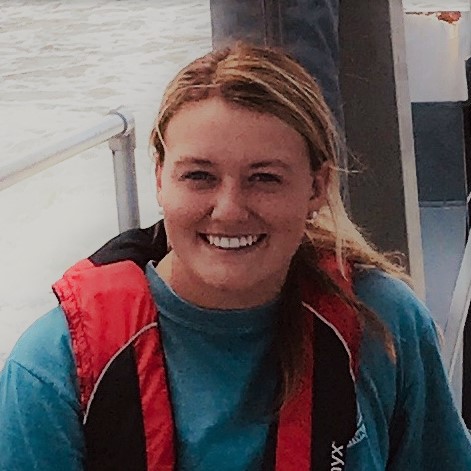
Sierra Hildebrandt, EPP Intern | Email: sierra.hildebrandt@my.hamptonu.edu
CSC Affiliation: NOAA-Living Marine Resources Cooperative Science Center
Home Institution and Major: Hampton University; Biological Sciences-Marine Science, M.S., Marine, Estuarine Environmental Sciences
CSC Academic Advisor: Dr. Deidre Gibson, Marine & Environmental Science | Email: deidre.gibson@hamptonu.edu
NOAA Internship Mentors: Dr. Shawn McLaughlin, Jason Spires, and Stephanie Westby, NOAA Cooperative Oxford Lab, Oxford, MD. | Email: shawn.mclaughlin@noaa.gov; jason.spires@noaa.gov
Project Category: Healthy Oceans
NERTO Title: Investigating the Impacts of Adult Oyster Conditioned Water on Crassostrea virginica Larvae Setting Efficiency Utilizing Direct Setting Techniques in the Hampton River, VA
Abstract
Direct setting is an alternative technique to remote setting that utilizes pediveliger stage oyster larvae to directly seed oyster reefs. This study investigated the impact of varying concentrations of Adult-Oyster-Conditioned-Water (OCW) on Crassostrea virginica larval setting in the laboratory and field. In the laboratory, oyster larvae were introduced to setting chambers with varying concentrations of OCW and allowed 7 days to settle. Field experiments were conducted in which oyster larvae were exposed to either a low or high OCW treatment for 30 minutes and then directly set on artificial oyster reefs. In the laboratory and field, setting efficiencies varied among treatments. This research suggest that OCW may enhance setting efficiencies in the field.
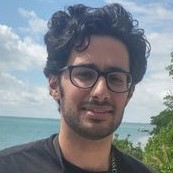
Juan Carlo Cervera, EPP Intern | Email: juan.cervera@rsmas.miami.edu
CSC Affiliation: NOAA-Living Marine Resources Cooperative Science Center
Home Institution and Major: University of Miami-RSMAS; M.S., Fishing & Fisheries Sci & Mgmt
CSC Academic Advisor: Dr. David Die, Marine Biology and Ecology | Email: ddie@rsmas.miami.edu
NOAA Internship Mentor: Dr. Jennifer Leo, NOAA SEFSC Galveston Lab, Galveston, TX. | Email: jennifer.Leo@noaa.gov
Project Category: Resilient Coastal Communities and Economies
NERTO Title: Inland Essential Fishery Habitat Mapper Application
Abstract
Essential fishery habitats (EFH) are designated to preserve and maintain those sensitive ecosystems vital to managed fishery species for growth, survival, and reproduction. Impact assessments are performed allowing NOAA specialists to consult with project managers, determine impacts, and recommend mitigation actions to protect those habitats. With many projects being developed in near shore areas, and little clear guidance regarding EFH designations in the Southeast Region, the Habitat Conservation Division (HCD) receives numerous unnecessary consultation requests which can overwhelm their office. We developed an application that relays high-resolution spatial data needed for accurate determinations of EFH that is user-friendly at all stakeholder levels, including developers, permitters, as well as HCD staff. Several iterations were considered before deciding on an HTML/JavaScript web application currently under testing with NOAA offices.
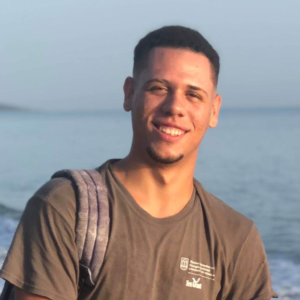
Angel Reyes Delgado, EPP/MSI Intern | Email: areyes@umes.edu
CSC Affiliation: NOAA-Living Marine Resources Cooperative Science Center
Home Institution and Major: University of Maryland Eastern Shore, Marine, Estuarine and Environmental Science
CSC Academic Advisor: Dr. Paulinus Chigbu, Department of Natural Science
Email: pchigbu@umes.edu
NOAA Internship Mentor: Brian Smith, NOAA NEFSC, Woods Hole, MA| Email: brian.smith@noaa.gov
Project Category: Healthy Oceans
NERTO Title: Diet Variation and Trophic Impact of Weakfish (Cynoscion regalis) Within Multiple Marine Habitats of the Eastern U.S.
Abstract
Weakfish (Cynoscion regalis) is a species that inhabits regions ranging from Nova Scotia, Canada all the way southward to Florida. They are currently regionally regulated, but they feed on important species that are federally regulated and of commercial interest. There are limited studies on weakfish diet variability among these essential prey. Therefore, our objectives were to determine 1) the most dominant prey in weakfish diet 2) if area, size class and year factors explain variation in diet, and 3) quantify how much prey biomass is removed by weakfish over time. We used diet data from The Chesapeake Bay Multispecies Monitoring and Assessment Program (CHESMMAP), the Northeast Area Monitoring and Assessment Program (NEAMAP) and the National Marine Fisheries Service (NMFS) bottom trawl surveys. We used trophic diversity (Shannon H index) curves to determine the adequacy of diet sampling for 3 factors: 1) area (Chesapeake Bay (CHESMMAP), inshore Mid-Atlantic Bight (NEAMAP), and offshore MAB (NMFS), 2) size category (small (1-25 cm) and medium (26-50 cm), and 3) temporal blocks (block 1: 2007-2013, block 2: 2014-2019). For objective 1 We weighted diet composition by mass following a 2-stage cluster sampling estimator based on the survey design. For objective 2, a Canonical Correspondence Analysis (CCA) was performed to examine how much variation these factors explain for the diet of weakfish. For objective 1 and 2 rare prey that constituted less than 1% were excluded. For objective 3, we estimated per capita consumption for each area with the gastric evacuation rate method. In general, the diet composition was mostly dominated by Engraulidae and Osteichthyes (unidentified bony fish) per area and size. The CCA showed that year was not significant, however the amount of variance explained by the 3 factors together was approximately 40%. We also found that prey biomass removed by weakfish occurred mostly at inshore areas. These results show that area and size are significant factors in weakfish diet variation, this highlights their opportunistic nature, and that cannibalism is an essential part of the weakfish diet.
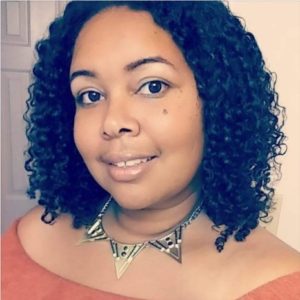
Ashley Silver, EPP/MSI Intern | Email: acsilver@umes.edu
CSC Affiliation: NOAA-Living Marine Resources Cooperative Science Center
Home Institution and Major: University of Maryland Eastern Shore, Marine, Estuarine and Environmental Science
CSC Academic Advisor: Dr. Paulinus Chigbu, Department of Natural Science
Email: pchigbu@umes.edu
NOAA Internship Mentor: Dr. Larry Alade, NOAA NEFSC, Woods Hole, MA| Email: larry.alade@noaa.gov.
Project Category: Healthy Oceans
NERTO Title: Analyses and Comparison of American Plaice Growth in the Georges Bank and Gulf of Maine Regions
Abstract
American plaice is a pleuronectid that inhabits relatively deep waters from southern Labrador on the eastern coast of Canada to Rhode Island. This species of flatfish is of interest for the investigation of new growth trends as it will be undergoing a research track assessment in 2022. Collaborating in a Working Group (WG) is a component of the research track within the stock assessment process of American plaice. The WG is composed of researchers from University of Massachusetts, School of Marine Science and Technology (SMAST), Northeast Fisheries Science Center (NEFSC), University of Maryland Eastern Shore, among others, participating in hybrid; half-day meetings, a meeting with fishermen, a multi-day meeting on data, and a multi-day meeting on models. WG members collaborate to contribute to specific Terms of References (TORs) in a series of working papers compiled into a Working Group Report. Working with my NOAA Experiential Research and Training Opportunities (NERTO) mentor and a fellow researcher, both NEFSC scientist, we went through the process of developing R-codes to conduct growth analyses to examine length-at-age and length-weight relationships of American plaice on data collected during the Spring and Autumn Bottom trawl surveys conducted by the NEFSC from 1980-2021. Our analyses show that growth is sexually dimorphic and a comparison of regional growth between Georges Bank and the Gulf of Maine indicate that size at age and weight at length were similar between regions. There was a temporal trend in size at age with higher maximum size achieved in the early 1980’s followed by a decline through the late 1990’s and 2000’s and increase in maximum size at age in the 2010’s. We hypothesized that these temporal trends in growth could be density-dependent as it appears to be correlated with stock productivity. This study demonstrates that accurate growth information plays a central role in providing reliable scientific advice for management.

Shakira Goffe, EPP/MSI Intern | Email: scgoffe@umes.edu
CSC Affiliation: NOAA-Living Marine Resources Cooperative Science Center
Home Institution and Major: University of Maryland Eastern Shore, Marine, Estuarine and Environmental Science
CSC Academic Advisor: Dr. Paulinus Chigbu, Department of Natural Science
Email: pchigbu@umes.edu
NOAA Internship Mentor: Dr. Larry Alade, NOAA NEFSC, Woods Hole, MA| Email: larry.alade@noaa.gov.
Project Category: Healthy Oceans
NERTO Title: Analyses and Comparison of American Plaice maturity Parameters in the Georges Bank and Gulf of Maine Regions
Abstract
In 2014, the NOAA Office of Education initiated an experiential Research and Training Opportunities (NERTO) for Cooperative Science Center students to engage in a 12-week immersion in NOAA mission aligned priorities. Students work collaboratively with a NOAA mentor and their academic advisor to foster networking and strengthen graduate education and workforce pipeline. Due to COVID-19, the program expanded its engagement to include a virtual component and I offer a case example with a stock assessment working group (WG) in the Northeast to highlight some of the best practices to support a successful internship experience. Due to some of the biological uncertainty in previous stock assessment of American plaice, estimates of maturity of American plaice on Georges Bank (GB) and in the Gulf of Maine (GOM) region were reevaluated during my internship for consideration in the research track assessment in 2022. I led the working group to analyze biological data collected by the Northeast Fisheries Science Center on the bottom trawl survey in the spring and fall seasons. Analysis and comparison of American plaice maturity parameters in the GB and GOM regions were done to meet the project’s objectives. To obtain the collective objective of the stock assessment working group, a variety of communication platforms were used on a routine basis. Technology played a vital role to facilitate communication but more importantly, the weekly check-ins by NOAA advisor to discuss technical details of the research and troubleshoot code remotely was crucial. The NERTO experience was a success due to the intentional and concerted effort to maintain communication. From the study, the WG concluded that American plaice males tend to mature faster than females and there are no regional differences in maturation rates between GB and the GOM. We recommend that the 2022 research track use an age-specific, time invariant single observed maturity ogive for American plaice on GB and in the GOM.
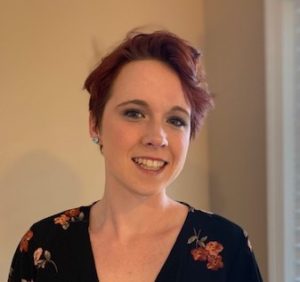
Caitlyn Czajkowski, EPP/MSI Intern | Email: Cmczajkowski20@students.desu.edu
CSC Affiliation: NOAA-Living Marine Resources Cooperative Science Center
Home Institution and Major: Delaware State University, Natural Resources
CSC Academic Advisor: Dr. Dennis McIntosh, Department of Agriculture & Natural Resources
Email: dmcintosh@desu.edu
NOAA Internship Mentor: Dr. John Jacobs, NOAA NOS, COL, Maryland | Email: John.Jacobs@noaa.gov
Project Category: Healthy Oceans
NERTO Title: A common food additive for removal of Vibrio spp. in Eastern Oysters (Crassostrea virginica)
Abstract
Vibrio spp. are naturally occurring bacteria present in coastal and estuarine waters worldwide, with some species being pathogenic to humans. Two species of concern are Vibrio parahaemolyticus and Vibrio vulnificus, in which infections are commonly associated with consumption of raw shellfish. The presence of Vibrio spp. in oysters has led to several strategies to mitigate risk including heavy management, post-harvest treatments and depuration. Despite the effectiveness of these strategies, Vibrio remains a growing concern to oyster producers, consumers and health officials. It is imperative that methods to reduce Vibrios are continuously explored. A common food additive, liquid smoke has 2 been validated both in vitro and on food systems to be an effective preservative and antimicrobial. It is theorized that the presence of phenols, organic acids and carbonyls contribute to these antimicrobial properties. The antimicrobial potential of liquid smoke against Vibrio spp. was analyzed using a microplate reader to determine optical density of suspended Vibrio parahaemolyticus cultures treated with liquid smoke at various concentrations over 30 hours. The microplate assays were validated using traditional plating methods over 24 hours using a 2% liquid smoke treatment.

Benjamin Frey, EPP/MSI Intern | Email: bfrey@umces.edu
CSC Affiliation: NOAA-Living Marine Resources Cooperative Science Center
Home Institution and Major: Univ. of Maryland Center for Env. Science; Marine Estuarine and Environmental Science
CSC Academic Advisor: Dr. David H. Secor, Chesapeake Bay Lab-UMCES
Email: secor@umces.edu
NOAA Internship Mentor: Dr. Anne Richards, NOAA NEFSC, Woods Hole, MA| Email: anne.richards@noaa.gov
Project Category: Healthy Oceans
NERTO Title: Validation of age and growth estimates of New England and Mid-Atlantic demersal fishes using microstructural analysis of hardparts
Abstract
Monkfish (Lophius americanus) supports high value fisheries in the Mid-Atlantic and Southern New England. Conservative fishing quotas were imposed owing to refutation of traditional ageing methods that resulted in uncertainties in stock status. Without accurate age interpretation or validation, serious errors in the assessment and management of fish stocks can occur. This internship at the NMFS Northeast Fisheries Science Center (NEFSC) examined the current assessment processes including fishery-independent methods, biological sampling, age determination methods for monkfish and other species (black sea bass, haddock, yellowtail flounder, red hake and silver hake) and age-dependent stock assessment models. I participated in a 2-week leg of the Northeast Fall Bottom Trawl Survey. I trained with the NEFSC Age & Growth group reviewing ageing methods for these species. I met with the assessment leads for each species, reviewing how age-dependent assessments are used in establishing biological reference points and evaluating stock status. My thesis research will continue to involve my NEFSC mentors as I develop novel approaches to age monkfish using trace element microconstituent analysis of hardparts.
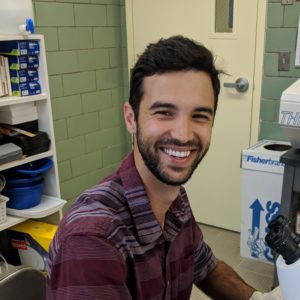
Brian Galvez, EPP/MSI Intern | Email: bgalvez17@students.desu.edu
CSC Affiliation: NOAA-Living Marine Resources Cooperative Science Center
Home Institution and Major: Delaware State University; Natural Resources
CSC Academic Advisor: Dr. Stacy Smith, DSU
Email: slsmith@desu.edu
NOAA Internship Mentor: Dr. Howard Townsend, NOAA NOS COL, Maryland| Email: howard.townsend@noaa.gov
Project Category: Healthy Oceans
NERTO Title: Determining diet of Delaware Bay weakfish using stomach content and stable isotope analysis
Abstract
The weakfish (Cynoscion regalis) is a valuable commercial and recreational fish species that primarily occurs from N. Carolina to New York. The fishery is depleted and has not rebounded due to unknown causes of elevated rates of natural mortality. We applied stable isotope and stomach content analyses to examine the diet of weakfish throughout the Delaware Bay from late spring to early fall in 2017 (May through October). Using these methods, our goal was to answer questions regarding the trophic ecology of weakfish including prey availability, prey preference, and prey origin. The bay was separated into three parts along the salinity gradient and weakfish were separated into three size classes representing ontogenetic shifts in diet (small- 0-60, medium- 60-100, large- 100-137 mm SL). We found that mysid shrimp, amphipods, and unidentified fish dominated the diet of weakfish throughout the summer and early fall. Examining stomach content by season, the percent frequency (%F) of mysid shrimp decreased significantly in the middle bay from late spring to summer (from 90 %F to ~60 %F) with a concurrent increase in amphipod consumption in the same period on the Delaware side of the bay (from ~15 %F to 90 %F). The opposite relationship between amphipod and mysid shrimp consumption was recorded from summer to fall. Stable isotope data was analyzed using generalized linear models (GLMs) and generalized linear mixed models (GLMMs) for each isotope by each size class weakfish with the variables of bay location, season, and state. The goal of the GLM and GLMM results was to inform the setup of future stable isotope mixing models in terms of spatiotemporal scales.

Chryston Best-Otubu, EPP/MSI Intern | Email: cjb291@miami.edu
CSC Affiliation: NOAA-Living Marine Resources Cooperative Science Center
Home Institution and Major: Univ. of Miami; Marine Biology and Ecology
CSC Academic Advisor: Dr. Elizabeth Babcock, Univ. of Miami-RSMAS
Email: ebabcock@miami.edu
NOAA Internship Mentor: Dr. Isaac Kaplan, Dr. Pierre-Yves Hernvann, Dr. Nerea Lezama-Ochoa, Northwest Fisheries Science Center, Seattle, WA|
Email: Isaac.kaplan@noaa.gov
Project Category: Healthy Oceans
NERTO Title: Spatial modeling of diets, predation, and the pelagic food web of the California Current
Abstract
Exploring the food web based on the abundance of certain forage fish is an important goal in establishing how the ecosystem changes. Forage fish not only support fisheries but are also important prey for many predators in the California Current. A recent development in food web analysis is the California Current Trophic Database (CCTD), containing thousands of predator diets. This database can be used to update stomach-based food web dynamics in the California Current. Here, we developed two Ecopath food web models to compare temporal changes of the predators most dependent on these forage fish, and which predators exert the strongest top-down mortality on forage stocks during certain temporal regimes. These two models estimate the variation of predator diet composition and mortality rates over two temporal regimes of sardine and anchovy abundance, one regime based on 5 years of high biomass and the other regime based on 5 years of low biomass. We used the R implementation of Ecopath and Ecosim called Rpath to build the models and calculated an index to determine which forage species have key ecological roles (Supportive Role to Fishery ecosystem, SURF). Our diet analyses found that most predators consumed higher levels of sardine and anchovy in the regime where forage fish biomass was high, and the proportion of forage fish in the predator diets decreased in the regime of low forage fish biomass. During the high biomass regime, the SURF index identified Anchovy as the only key species. These food web models can be used not only to determine which predators should be considered in monitoring forage fish mortality but also the outputs could supplement the future modeling experience with the outputs/lessons learned from our Ecopath food web modeling efforts.
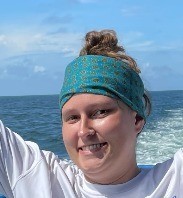
Cloe Lemaire, EPP/MSI Intern | Email: clemaire@student.savannahstate.edu
CSC Affiliation: NOAA-Living Marine Resources Cooperative Science Center
Home Institution and Major: Savannah State University; Marine Scienc
CSC Academic Advisor: Dr. Dionne Hoskins-Brown, Savannah State University
Email: hoskinsbrown@savannahstate.edu
NOAA Internship Mentor: Dr. Jennifer Doerr, Southeast Fishery Science Center, Habitat Ecology Branch | Email: jennifer.doerr@noaa.gov
Project Category: Healthy Oceans
NERTO Title: Galveston Bay Microhabitat Monitoring Pilot Study
Abstract
Present-day variability in environmental factors provides means for understanding organismal responses under future climate change scenarios. Measuring current ranges of environmental factors including, salinity, temperature, and pH, provides insight into the scale of values organisms are currently exposed to. The difference between local maximums and minimums will likely increase with time and human activity. Coastal habitats are especially vulnerable to variability due to their proximity to humans. Excessive inputs to the system can result in harmful stochastic events, such as algal blooms, which cause immediate changes to the local carbon system. The chemistry of marine ecosystems is a fine balance between all the interacting factors including, pH, dissolved inorganic carbon (DIC), alkalinity, and pCO2. This balance is easily disrupted and can result in shifts in carbonate availability required for calcifying organisms. The life of estuarine organisms is highly variable on short timescales, resulting in enhanced adaptability of these organisms to changing environmental conditions and highly valuable to research. This pilot study aims to provide baseline values of pH, temperature, and salinity variability among three study sites across Galveston Bay, TX and across three microhabitat types (open water, marsh edge, and tidal creek) within each site. No significant differences were found between microhabitats, but differences in nutrient concentrations (nitrate and phosphate), dissolved inorganic carbon (DIC) and calcite saturation index were detected across locations. The fresher location (Hog Island) measured higher phosphate, lower nitrate and lower DIC and calcite saturation indices in comparison to the more saline location (State Park). This is the first of several studies that captures present-day values for comparison, then applies the methodology to other estuarine systems to better understand microscale fluctuations in the carbon system.
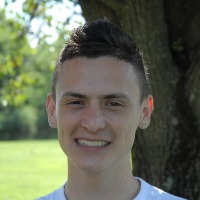
David Garcia Prieto, EPP/MSI Intern | Email: dgarcia@umces.edu
CSC Affiliation: NOAA-Living Marine Resources Cooperative Science Center
Home Institution and Major: Univ. of Maryland Center of Env. Sciences, Horn Point Laboratory; Marine Estuarine and Environmental Science
CSC Academic Advisor: Dr. Clara Fuchsman, Univ. of Maryland Center of Env. Sciences
Email: cfuchsman@umces.edu
NOAA Internship Mentor: Dr. Matthew Galaska, NOAA PMEL, Seattle, Washington & Dr. Sean McAllister, NOAA PMEL, Seattle, Washington
Email: matt.galaska@noaa.gov
Project Category: Healthy Oceans
NERTO Title: A temporal analysis of microbes in the Salish Sea using 16S rRNA
Abstract
Marine microbes, which include single-celled Bacteria, Archaea, and Eukarya (i.e. diatoms, foraminifera), play critical roles in global nutrient and carbon cycling and can be considered bottom-up controls of the marine food web. Human induced change is directly affecting the coastal ocean through the increase of carbon dioxide in ocean waters, leading to ocean acidification, as well as excess nutrient runoff from fertilizers/waste resulting in algal blooms and hypoxic zones associated with large die offs. The Salish Sea (Puget Sound, WA) is commercially relevant and hosts many species susceptible to these changes, like oysters and other shellfish. It is important for us to monitor microbial communities through time and space in order to get a better understanding of the normal seasonal dynamics of these populations, to better be able to detect and predict the effects of large scale physical and chemical environmental changes caused by climate change. This project focused on a temporal (Spring/Summer) analysis of the microbial community of the Salish Sea at three stations. It included a five-day research cruise where summer samples were obtained. Samples underwent: DNA extraction, PCR amplification, 16S rRNA gene sequencing with a Nanopore sequencer, and bioinformatic analysis as part of a longer-term monitoring program that will test the hypotheses that changes in microbial and zooplankton community composition are due to changes in pH, eutrophication, and increased hypoxia, controlling for normal seasonal change. Key findings of this smaller work were: 1) the microbial community shifted between Spring and Summer partially due to changes in stratification, 2) potential HAB (Harmful Algal Bloom) species of algae were identified in many of our samples and at station P28, Pseudo-nitzschia sp., a potential domoic acid producing diatom, represented almost half the summer surface community near Golden Gardens, a popular Seattle beach, 3) oxygen, salinity, density, and temperature all significantly affected the microbial composition at our sites, and 4) Nanopore sequencing is a valuable tool with a rapid turnaround that can be used to quickly assess risk for recreation and shellfish farming in coastal waters.

Emily Andrade, EPP/MSI Intern | Email: Eandrade21@students.desu.edu
CSC Affiliation: NOAA-Living Marine Resources Cooperative Science Center
Home Institution and Major: Delaware State University; Natural Resources
CSC Academic Advisor: Dr. Gulnihal Ozbay, Delaware State University
Email: gozbay@desu.edu
NOAA Internship Mentor: Dr. Joseph Dietrich, NOAA NWFSC, Newport, OR
Email: joseph.dietrich@noaa.gov
Project Category: Resilient Coastal Communities and Economies
NERTO Title: Antimicrobial assessment of macroalgae species for use as feed additives during aquaculture of sablefish
Abstract
Excessive use of antibiotics in aquaculture is a practice that can lead to antibiotic resistance in many pathogens. The increased desire for natural food supplements to replace antibiotics in aquaculture diets has inspired the testing of many different plant additives to assess potential increased bacterial resistance and immune system responses in commercially raised species. The purpose of the project as a whole was to develop experimental tools and assess which macroalgae species are capable of dietarily boosting the disease resistance and immune function of cultured sablefish (Anoplopoma fimbria). The objectives of this initial step of the project were to assess the antimicrobial activity of two species of seaweed, Turkish towel (Chondracanthus exasperates) and dulse (Palmaria palmata) using a resazurin assay. Resazurin, a compound that changes color with bacterial growth, was added to 96-well plates and monitored in a spectrophotometer over time after the addition of macroalgae extract. Results indicate a need for additional extraction methods and expanded time frames for any additional work that might be conducted. In addition to the data generated, this project also created a standard framework and procedure for future kinetic analysis work using spectrophotometer readings and resazurin assays.

Hillary Thalmann, EPP/MSI Intern | Email: hillary.thalmann@oregonstate.edu
CSC Affiliation: NOAA-Living Marine Resources Cooperative Science Center
Home Institution and Major: Oregon State University; Fisheries Science
CSC Academic Advisor: Dr. Jessica Miller, Oregon State University
Email: jessica.miller@oregonstate.edu
NOAA Internship Mentor: Dr. Benjamin Laurel, NOAA NMFS AFSC, Newport, Oregon
Email: ben.laurel@noaa.gov
Project Category: Healthy Oceans
NERTO Title: Assessing Pacific Cod metabolic rate under variable temperature scenarios using otolith stable isotopes and microchemistry
Abstract
Warming oceans and more frequent marine heatwave events can lead to increases in fishes’ metabolic rate, resulting in changes to their foraging, growth, and survival in warm conditions. In recent years, the Gulf of Alaska Pacific Cod (Gadus macrocephalus) population declined dramatically in response to two marine heatwave events in the region. Pacific Cod metabolic demand was likely elevated during the heatwaves; however, there is currently no well-established methodology for quantifying the metabolic rate of fish in the field as they encounter thermal stress. It is hypothesized that metabolic rate can be estimated from the isotopic composition of carbon (𝛿13 ) in fish otoliths or from magnesium and phosphorous trace elements in otoliths (Limburg and Casini 2018; Chung et al. 2019; Martino et al. 2020). None of these potential proxies have been explored for Pacific Cod, and our objectives for this study are to 1) assess the validity of otolith carbon isotopes and Mg:Ca and P:Ca microchemistry as metabolic proxies for age-1 Pacific Cod, and 2) examine how Pacific Cod metabolic rate varies under different temperature conditions. This is the second of two experiments for my dissertation that focus on understanding potential otolith proxies for metabolic rate. The first experiment focused on metabolic rate in response to moderate temperatures that Pacific Cod might experience in a normal year, while this second experiment is focused on temperatures that would be more common in a marine heatwave event. We exposed Pacific Cod to 3 temperature treatments (6, 10, and 14°C) for twelve months and determined their Standard Metabolic Rate (SMR) using swim tunnel respirometry. We will next analyze the otoliths for carbon stable isotope chemistry and Mg:Ca and P:Ca microchemistry analysis and compare these values to the known SMR for each fish. An otolith-derived metabolic proxy for Pacific Cod would be helpful for evaluating changes in field metabolic rate under stressful temperature conditions and allow for more informed management and conservation of the species.

Imani Wilburn, EPP/MSI Intern | Email: iswilburn@umes.edu
CSC Affiliation: NOAA Living Marine Resources Cooperative Science Center
Home Institution and Major: University of Maryland Eastern Shore; Marine, Estuarine and Environmental Science.
CSC Academic Advisor: Dr. Maurice Crawford, UMES | Email: mkcrawford@umes.edu
NOAA Internship Mentor: Dr. Ashok Deshpande, NOAA NEFSC, J.J. Howard Lab, Sandy Hook, NJ | Email: ashok.deshpande@noaa.gov
Project Category: Healthy Oceans
NERTO Title: Quantifying Microplastics in Maryland Coastal Bay Fish and Sediments
Abstract
A major problem in the world is plastic in the ocean, with 8 million tons of plastic from coastal nations entering the ocean yearly. Microplastics are tiny pieces of plastic, 5 mm or smaller, that originate from the breakdown of larger pieces of plastic. Because they are so small, it is easy for organisms to ingest them and considerably harder to remove them from the environment. To better understand the extent of this problem in the Maryland Coastal Bays, previously collected filters containing digested fish material were examined for microplastics. Microplastics of sufficient size were run through a pyrolysis gas chromatography-mass spectrometry (GC-MS) machine in order to identify the type of plastic collected. A method was tested using microplastic beads, vegetable oil, magnets, and ferrous fluid to remove microplastics from water.
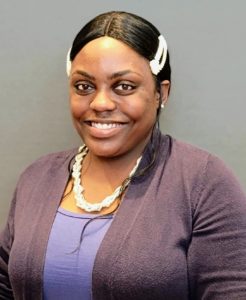
Jasmine Smalls, EPP/MSI Intern | Email: jsmalls@umes.edu
CSC Affiliation: NOAA Living Marine Resources Cooperative Science Center
Home Institution and Major: University of Maryland Eastern Shore; Food/Environmental Microbiology.
CSC Academic Advisor: Dr. Salina Parveen, UMES | Email: sparveen@umes.edu
NOAA Internship Mentor: Dr. John Jacobs, NOAA/NCCOS and Dr. Howard Townsend, NOAA/NMFS/ST/Ecosystems Cooperative, Oxford Lab | Email: John.Jacobs@noaa.gov & Howard.Townsend@noaa.gov
Project Category: Resilient Coastal Communities and Economies
NERTO Title: Prevalence of Vibrio parahaemolyticus and Vibrio vulnificus in Blue Crabs (Callinectes sapidus) and Seawater Harvested from the Maryland Coastal Bays.
Abstract
Climate change can cause an increase in the prevalence of Vibrios, alter microbial communities in aquatic species and their surrounding environment, and increase the emergence of antimicrobial resistant and genetically diverse bacteria. Fluctuations in physicochemical parameters can impair water quality and the productivity of blue crabs (Callinectes sapidus). The increase of naturally contaminated crustaceans and water columns can ultimately increase the risk of human exposure to various Vibrio related illnesses. Thus, this study aims to determine the prevalence of total Vibrio parahaemolyticus (Vp) (tlh) and Vibrio vulnificus (Vv) (vvhA) along with pathogenic markers of Vp (tdh and trh) and Vv (vcgC) in blue crabs and seawater from the Maryland Coastal Bays (MCBs) and the correlation between Vibrio levels and physicochemical parameters by developing predictive linear models. Three to five crabs and one liter of seawater will be collected from six sites within the MCBs for three years. Crabs will be collected from April to October and seawater will be collected from January to December. Hemolymph and crab tissue will be extracted and pooled for each site. Extracted hemolymph, crab tissue, and seawater will be analyzed for Vp and VV using Most Probable Number (MPN) and real time PCR. The outcomes of this study will provide valuable information regarding the spatial and temporal distributions of Vibrio spp. and their effect on microbial communities in blue crabs and their surrounding environments. Furthermore, this study provides insight on species diversity, phylogenetic compositions, genetic properties, and genomic distribution profiles of Vp and Vv in blue crabs and seawater in the MCBs. All approaches will help in risk assessments that are essential in the overall advancement of the quality and safety of public health.

Janelle Layton, EPP/MSI Intern | Email: janelle.layton@noaa.gov
CSC Affiliation: NOAA Living Marine Resources Cooperative Science Center
Home Institution and Major: Oregon State University; Fisheries Science.
CSC Academic Advisor: Dr. Scott Heppell, Oregon State University
Email: scott.heppell@oregonstate.edu
NOAA Internship Mentor: Dr. Chris Harvey, NOAA NWFSC, Seattle, WA
Email:
chris.harvey@noaa.gov
Project Category: Healthy Oceans
NERTO Title: Species Distribution Modeling of Climate Vulnerable West Coast Groundfishes
Abstract
There are over 90 different types of groundfishes, including rockfish, flatfish, elasmobranchs, and more, along the west coast of the United States. Given predicted changes in the coming century to the world’s oceans, there is a need to characterize how these changes will affect the distribution and community assemblages of these economically, educationally, and culturally important fishes (Thompson et al 2022). To address this need, this study used species distribution modelling combined with downscaled ocean climate projections to assess future distributions of 32 species of groundfishes with a range of climate vulnerability, according to a recent expert elicitation (McClure et al 2022). Species distribution modeling was performed using sdmTMB, an R package used for fast, flexible, and user-friendly fitting of spatial and spatiotemporal predictive process generalized linear mixed effects models using Template Model Builder (TMB) and random fields (Anderson et al 2022). The following combinations of environmental variables were assessed as predictors in the models: 1) bottom temperature and dissolved oxygen; 2) bottom temperature, dissolved oxygen, and substrate; 3) bottom temperature, dissolved oxygen, and depth; or 4) bottom temperature, dissolved oxygen, substrate, and depth. The best fitting model was selected for each species analyzed, using 2- fold cross validation. Outputs from each model include spatial catch per unit effort (CPUE) estimates for each species in each year from 1980 to 2100. From these data, diagnostic plots, environmental affinity plots, annual maps, and difference maps were created to visualize model fit, environmental relationships, and spatial distribution patterns for each species. We observed a range of future distribution patterns among study species, including movement north, movement offshore, an overall decline in CPUE, simultaneous movement north and offshore, and minimal change in CPUE. Overall, there are many potential consequences of distribution changes for groundfishes along the west coast in response to climate change. Potential outcomes depend on the life history and climate vulnerability status of each species.

Jennifer Wong-Ala, EPP/MSI Intern | Email: wongalaj@oregonstate.edu
CSC Affiliation: NOAA Living Marine Resources Cooperative Science Center
Home Institution and Major: Oregon State University; Ocean, Earth and Atmospheric Sciences.
CSC Academic Advisor: Dr. Lorenzo Ciannelli, Oregon State University
Email: lorenzo.ciannelli@oreognstate.edu
NOAA Internship Mentor: Dr. Johanna Wren, Dr. Donald Kobayashi, Dr. Ryan Rykaczewski – NOAA NMFS, PIFSC, Honolulu, HI | Email: johanna.wren@noaa.gov
Project Category: Healthy Oceans
NERTO Title: Transport of Toxoplasma gondii oocysts in coastal areas inhabited by the Hawaiian monk seal
Abstract
Toxoplasmosis is a disease caused by the protozoan parasite Toxoplasma gondii and is one of the most common parasitic infections in warm-blooded animals. Contamination in the environment is widespread due to the shedding of oocysts (i.e., a hardy, thick-walled stage in the life cycle of coccidian parasites) by domestic cats and other Felids. For the critically endangered Hawaiian monk seal (Neomonachus schauinslandi), Toxoplasmosis is the leading cause of death for female adult seals, with adult females accounting for 10 out of the 14 monk seals known to have died from Toxoplasmosis. My NERTO aims to assess the transport and connectivity of the parasite Toxoplasma gondii in waters near the Hawaiian Archipelago and investigate coastal regions where the parasite may be accumulating concerning the location of Hawaiian monk seals.Due to contracting Covid-19 after arriving in Honolulu, HI, my NERTO was impacted, and I could not do all of the objectives I stated in my 12-week plan. However, I was still able to conduct research that is related to the described project. In addition, to conduct the connectivity analyses, I gave presentations about T. gondii and Toxoplasmosis to build a relationship with cat-related networks interested in managing T. gondii spread in Hawai‘i. I was also introduced to researchers who work closely with the HMSRP, Drs. Karen Shapiro and Kim Falinski. In the particle tracking model, I conducted parameterization of the ocean transport model and preliminary analyses of oocyst transport in the ocean. I formulated connectivity matrices to establish the likely pathways of oocysts once they enter the ocean. These steps are essential to get this project moving forward and make connections with those in the Toxoplasmosis community on the island. These steps are also essential to increase my professional network and workforce training that pertains to NOAA missions.
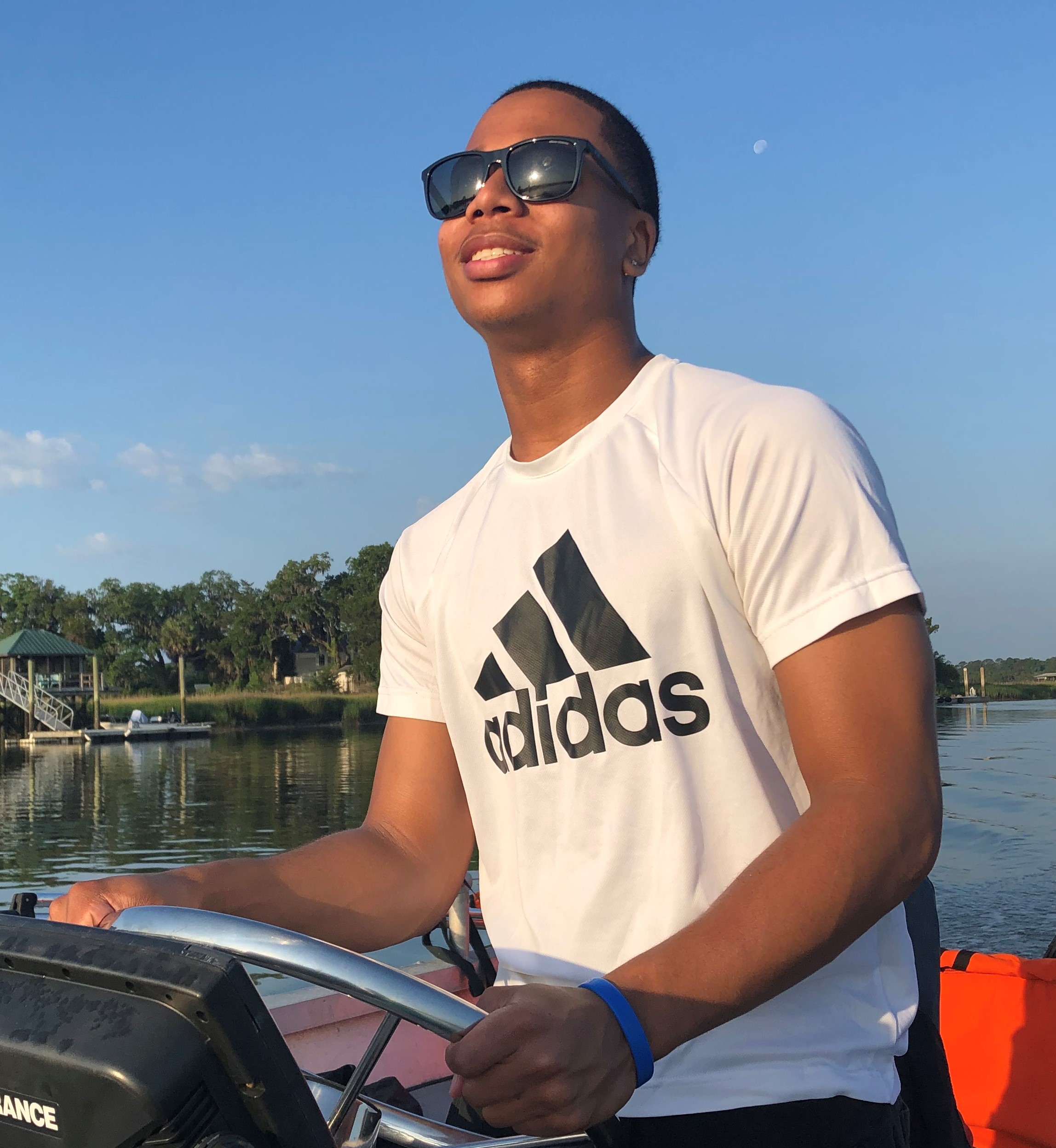
Joe Day Jr., EPP/MSI Intern | Email: jday3@student.savannahstate.edu
CSC Affiliation: NOAA Living Marine Resources Cooperative Science Center
Home Institution and Major: Savannah State University; Marine Sciences.
CSC Academic Advisor: Dr. Tara Cox, Savannah State University, Department of Marine and Environmental Sciences | Email: coxt@savannahstate.edu
NOAA Internship Mentor: Dr. Eric Archer, Dr. John Carlos Garza – NOAA SWFSC | Email: eric.archer@noaa.gov, carlos.garza@noaa.gov
Project Category: Healthy Oceans
NERTO Title: Genetic Analysis of Tamanend’s Bottlenose Dolphins (Tursiops erebennus)
Abstract
Bottlenose dolphins (Tursiops spp.) are distributed widely in the Atlantic Ocean, including estuaries and coastal waters. NOAA National Marine Fisheries Service has identified 10 Bay, Sound, and Estuarine (BSE) stocks of bottlenose dolphins along the Atlantic coastline of the US. Delineating stock structure has been difficult because there is high overlap between BSE and coastal bottlenose dolphins and accurately identifying BSE stock boundaries requires an integrative approach. The Northern Georgia/Southern South Carolina Estuarine System (NGSSCES) stock of bottlenose dolphins ranges from the North Edisto River, South Carolina through northern Ossabaw Sound, Georgia, as determined through photo-ID and satellite-linked telemetry. A previous study detected fine-scale population subdivision through the integration of photographic identification and mitochondrial DNA control region sequences. The purpose of the present study is to evaluate fine-scale population structure of Tamanend’s bottlenose dolphins (Tursiops erebennus) using photo-ID and genetics. The objectives of the study are to determine the levels of sibship within BSE and coastal dolphins, characterize genetic variability within BSE dolphins, and estimate gene flow between the BSE and coastal dolphins. We examined genotypes from 41 dolphins from the Skidaway River estuary, GA and 19 coastal dolphins from North Carolina generated with double digest restriction site-associated DNA sequencing (ddRADseq). Parentage analysis using Colony will be used to estimate relationships and relatedness among groups. The relatedness likelihoods will be examined in light of individual sighting histories to inform inferences about the family structure of BSE dolphins. The degree of relatedness within the BSE dolphins will also be compared with relatedness within the coastal population. Understanding patterns of relatedness and determining fine-scale population structure in BSE and coastal bottlenose dolphins will provide valuable genetic information for stock delineation and other management actions.

Kaitlynn Wade, EPP/MSI Intern | Email: kjwade@umes.edu
CSC Affiliation: NOAA Living Marine Resources Cooperative Science Center
Home Institution and Major: University of Maryland Eastern Shore; Marine, Estuarine and Environmental Science.
CSC Academic Advisor: Dr. Daniel Cullen, UMES, Department of Natural Sciences
Email: dwcullen@umes.edu
NOAA Internship Mentor: Dr. Kevin Craig and Dr. Kyle Shertzer– NOAA SEFSC, Beaufort, NC
Email: kyle.shertzer@noaa.gov & kevin.craig@noaa.gov
Project Category: Healthy Oceans
NERTO Title: Low Recruitment in US South Atlantic Reef Fish
Abstract
Atlantic reef fishes off the southeastern United States support a multispecies fishery that is important commercially and ecologically. Several snappers and groupers in this fishery have experienced low recruitment in the most recent decades due to unknown causes. Recruitment is important in understanding the stock status and overall health of an organism. An analysis of the autocorrelation and partial autocorrelation within the most recent stock assessments for ten species showed that nine of them experienced a significant autocorrelation of lag one. Three species (gag grouper, snowy grouper, and scamp grouper) also showed decadal cyclic patterns. Correlations and PCA analyses showed that these fish form two groups. These groups are based on fish that are experiencing low recruitment and those that are not. This work also specifically evaluates the hypothesis that overfishing is a main driver causing low recruitment in some of these species. After analyzing different metrics to evaluate recruitment overfishing with simulation data and applying adequate metrics to the most recent fishing and recruitment estimates for each fishes’ stock assessment, it was found that fishing is an unlikely driver causing low recruitment in all species. Other hypotheses that are potentially influencing these species include environmental conditions, changes in predation, or competition from other organisms.
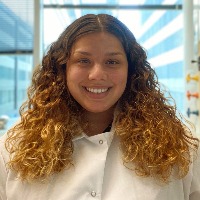
Olivia Pares, EPP/MSI Intern | Email: opares@umces.edu
CSC Affiliation: NOAA Living Marine Resources Cooperative Science Center
Home Institution and Major: University of Maryland Center of Environmental Science-IMET, Marine, Estuarine and Environmental Science
CSC Academic Advisor: Dr. Eric Schott, IMET
Email: schott@umces.edu
NOAA Internship Mentor: Helena Antoun – NOAA Southeast Regional Office
Email: helena.antoun@noaa.gov
Project Category: Healthy Oceans
NERTO Title: A Systematic Review of the Disease Ecology and Conservation & Management strategies of Stony Coral Tissue Loss Disease
Abstract
Stony Coral Tissue Loss Disease (SCTLD) is a highly infectious disease that destroys the soft tissue of many stony coral species, causing a significant coral loss in every reef it infects in approximately three to six weeks. SCTLD first appeared in Miami, Florida, in 2014, and by 2019, SCTLD was reported in Mexico, Belize, and the Caribbean Islands. The pathogen(s) responsible for SCTLD have yet to be confirmed. Coral microbiome analysis using 16s rRNA sequencing has shown that SCTLD is associated with a shift in the microbial community. However, histology of coral tissue infected with SCTLD has demonstrated a breakdown of the host and endosymbiont symbiosis rather than bacteria associated with tissue death. Research using transmission electron microscopy on SCTLD infected and healthy coral hypothesize that SCTLD is a viral disease of endosymbionts leading to coral host death. Whether the putative pathogen(s) responsible for SCTLD is bacterial, viral, or due to environmental stress has eluded researchers. To better decipher the disease dynamics of corals, the complexities of the host, pathogen, and environment triad of ecological factors must be considered for disease management and research. To address this, we aim to synthesize the available knowledge in a comprehensive review of SCTLD peer-reviewed scientific literature, complemented with gray literature, and on-site collaborations with coral resource managers, researchers, and educators. This review will highlight knowledge gaps that facilitate the development of best management practices and research recommendations for SCTLD.

Sena Tay, EPP/MSI Intern | Email: senadtay@gmail.com
CSC Affiliation: NOAA Living Marine Resources Cooperative Science Center
Home Institution and Major: Savannah State University, Marine Science
CSC Academic Advisor: Dr. Tara Cox, Savannah State University | Email: coxt@savannahstate.edu
NOAA Internship Mentor: Dr. Irvin Schultz, NWFSC, Seattle, WA | Email: irvin.schultz@noaa.gov
Project Category: Healthy Oceans
NERTO Title: Common bottlenose dolphin contaminant analysis
Abstract
Persistent organic pollutants (POPs) are a group of lipophilic and hydrophobic anthropogenic compounds that are resistant to environmental degradation. The purpose of this study was to determine the POP concentration in the blubber of common bottlenose dolphins (Tursiops truncatus) in the Skidaway River estuary near Savannah, GA. Biopsy samples were collected in Feb and Mar 2017 and 2019 from 81 individuals and analyzed for POPs in Summer 2019. Biopsy samples were analyzed for a suite of POPs using gas chromatography/mass spectrometry (GC/MS). The mean ΣPOPs in male common bottlenose dolphins was 39 μg/g lipid weight compared to 8.8 μg/g lipid weight for females. The class with the highest measured levels in both sexes was ΣPCBs, with 28 μg/g and 6.9 μg/g lipid weight in males and females, respectively. In females, the highest concentrations for all classes of POPs were in individuals that had never been observed with a calf.

Kyarii Ramarui, EPP/MSI Intern | Email: kramarui@umces.edu
CSC Affiliation: NOAA Living Marine Resources Cooperative Science Center
Home Institution and Major: Univ. of Maryland Center for Env. Science-IMET; Marine, Estuarine and Environmental Science
CSC Academic Advisor: Dr. Yantao Li, Univ. of Maryland Center for Env. Science-IMET
Email: yantao@umces.edu
NOAA Internship Mentor: Dr. Gary Wikfors, NOAA NEFSC Milford Lab, CT| Email: gary.wikfors@noaa.gov
Project Category: Healthy Oceans
NERTO Title: Flow cytometric investigation of the high-light stress response of heterotrophically grown mutant Haematococcus pluvialis strains
Abstract
Over the past decade, wild salmon harvest has been declining, and salmon aquaculture is expanding, thereby increasing the demand for sustainable and nutritious feed components. The green microalga, Haematococcus pluvialis, is an essential feedstock component for salmon aquaculture because of its high astaxanthin content. Astaxanthin is an antioxidant that has a provitamin A effect in Atlantic salmon, is essential for fry health and growth, and imparts salmon flesh with its characteristic pink color. In nature, salmon obtain astaxanthin from prey that biomagnify the pigment synthesized de novo by phytoplankton. Slow heterotrophic growth of H. pluvialis has impeded widespread industrial cultivation. Overcoming the slow heterotrophic growth rate of H. pluvialis can enable its widespread use as a feedstock and better support the transition to more sustainable salmon aquaculture. Molecular investigation of H. pluvialis metabolic and cell cycle pathways active under heterotrophic conditions can enable more efficient cultivation strategies or targets for strain engineering. One method of improving the heterotrophic growth rate is to promote individual cell growth and division; however, knowledge gaps regarding the cell cycle and its regulation in H. pluvialis remain. To advance this research, flow cytometry was used to monitor the content of cellular components, e.g., DNA, chlorophyll, carotenoids, and lipids, in dividing H. pluvialis cells to better understand this process. The results of this study found that the two mutant strains achieve higher cell densities than the wild type under heterotrophic cultivation conditions, but similar biomass concentrations, indicating that the mutant strains may be partitioning more carbon and energy towards cell division than the wild type. Additional analysis of the flow cytometric data and processing of samples is ongoing to continue characterizing the mutant strains.
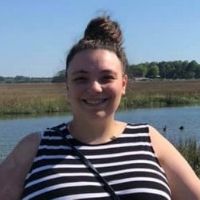
Savannah Geiger, EPP/MSI Intern | Email: Savannahgeiger35@gmail.com
CSC Affiliation: NOAA Living Marine Resources Cooperative Science Center
Home Institution and Major: Savannah State University; Marine Science
CSC Academic Advisor: Dr. Sue C. Ebanks, Department of Marine and Environmental Sciences
Email: sebanks@savannahstate.edu
NOAA Internship Mentor: Dr. Kimberly Roberson, NOAA NOS, Gray’s Reef National Marine Sanctuary, Savannah GA | Email: Kimberly.roberson@noaa.gov
Project Category: Healthy Oceans
NERTO Title: An analysis of fish abundance correlation to live-bottom habitat within Gray’s Reef National Marine Sanctuary
Abstract
Red Snapper, a federally managed, fishery, and sport fish species will be analyzed to determine if there is a correlation between fish size class and ledge height within Gray’s Reef National Marine Sanctuary. An analysis of similarities test will be preformed to determine the aforementioned scientific question. A long-term data set of approximately 12 years was provided by Dr. Roldan Munoz from the NCCOS Beaufort, NC Laboratory that contains all fishes sighting history during annual summer dive surveys. The current hypothesis is that larger (50 – >90 cm) Red Snapper will be sighted significantly more near taller ledges, and smaller Red Snapper (10 – 50 cm) will be sighted significantly more near shorter ledges. The results of this study will better inform management of Gray’s Reef and aid in determining if there are certain areas of the Marine Sanctuary that need additional restrictions and management emphasis. Lastly, the product of this analysis will be able to be used by Gray’s Reef National Marine Sanctuary to determine any organism size class correlation to ledge height with respect to time.
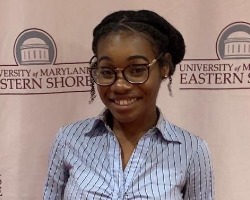
Tahirah Johnson, EPP/MSI Intern | Email: tjohnson7@umes.edu
CSC Affiliation: NOAA Living Marine Resources Cooperative Science Center
Home Institution and Major: University of Maryland Eastern Shore; Food and Environmental Microbiology
CSC Academic Advisor: Dr. Salina Parveen, Department of Food, Agricultural and Resource Science
Email: sparveen@umes.edu
NOAA Internship Mentor: Dr. John Jacobs & Dr. Howard Townsend |NOAA NCCOS Cooperative Oxford Laboratory, MD | Email: Kimberly.roberson@noaa.gov
Project Category: Healthy Oceans
NERTO Title: Prevalence and environmental determinants of Shewanella spp. in the Chesapeake and Maryland Coastal Bays.
Abstract
Shewanella species are flesh-eating and food spoilage bacteria that can be transmitted through contaminated water and seafood. Immunocompromised individuals are at greater risk of infection if raw or lightly cooked oysters are consumed, or if cuts in the skin have been exposed to contaminated marine environments. Adequate information is not available on the abundances of these bacteria in oysters (Crassostrea virginica) and seawater from the Chesapeake and Maryland Coastal Bays. The objective of this study was to evaluate the incidence and pathogenic potential of Shewanella species in the Chesapeake and Maryland Coastal Bays. From June 2019 through October 2021, oyster (n =63) and seawater (n =64)samples were collected monthly from three sites in the Chesapeake Bay and one site in the Maryland Coastal Bay. Seawater temperature, salinity, dissolved oxygen, turbidity, pH, chlorophyll- a, precipitation, atmospheric pressure, total dissolved solids and air temperature were also recorded during each sampling time-point. All samples were plated on iron agar and confirmed using 16S rRNA sequencing. Eighty-one percent (1,013) of all isolates tested were positive for Shewanella spp. Confirmed isolates were tested for hemolytic activity using blood agar plates. The counts ranged from undetectable to 3.53 × 10^4 in oyster; with Horn Point having the highest count in September of 2020 and undetectable to 2.9 X 10^2 in water; with Tangier Sound having the highest count in September 2019. The levels of Shewanella were significantly higher (p<0.05) in oysters than in seawater. The top four species isolated from oyster and water samples were S. amazonensis, S. marisflavi, S. lohica and S. algae. Forty-four percent of the oyster and water isolates were beta hemolytic. There was a moderate positive correlation (r=0.5-0.6) between Shewanella counts and seawater temperature and turbidity. This is the first comprehensive study that provides insight on the diversity and pathogenic potential of different Shewanella species recovered from oysters and seawater from the Chesapeake and Maryland Coastal Bays.


